This was the adventure of a lifetime. We saw some of the rarest geology on the planet, and caved through 5km of limestone underneath snakes, boars, tigers and the rest of the thick, war torn Vietnamese jungle.
Our hostel host Linh went over some tour and adventure options for while we were in Phong Nha. Larger caves, more remote, deeper in the jungle. They all sounded somewhat similar to us. When a company discovers a cave here, that company has exclusive access to provide tours to that cave. So competing companies all offer the same type of thing, just in a different location. Some crawling around, maybe a swim, and exploring the massive openings that make up Phong Nha National park. But one tour caught my eye for something different. A karst collapse.
What is a karst collapse? Quick geology lesson here. When a cave starts getting too big, especially near the surface, the roof of the cave becomes weak. It eventually will cave in, crashing to the bottom of the cave, and exposing the permanent darkness to light. What results is essentially a massive hole open to the surface, with caves stretching out from many directions. Some are accessible by walking down from the top. Most are not.
The karst collapse in question here was the Kong Collapse. Only discovered in 2019, this collapse remains essentially a scientific unknown, as most collapses are. By design, collapses are generally located in where lots of caves are, near exclusively limestone mountains. And in places with a lot of rain and flooding, so near exclusively a jungle. Some of the hardest terrain to traverse is limestone jungle, cause there is no easy method of navigation. You can’t follow rivers, they just disappear into caves. As a result, collapses are still being newly found (mostly in China and Vietnam) and studied.
We signed up for the tour, and got ready for the three day two night adventure that lay before us.
We were the only ones that signed up for this tour, so it was private access for us to our area of the jungle. We were joined by our main tour guide, Kong, and a guide in training, King. Those were their nicknames at least. We also had four other support staff who did not speak English, a safety guy and three porters. Reluctantly, the porters were necessary, as they took different, easier non-cave routes to our camps, bringing food and shelter. They wouldn’t have fit where we went.
Kong got us our gear ready to go, gave us a tour run down. We would explore three caves, all on day 2, and camp in the collapse and a cave entrance. He gave us a heads up for sharp rocks, spiky trees and leeches. Then we left. It was an hour through the twisted roads of Phong Nha National Park, our driver expertly dodging pot-holes, other drivers, dogs and cows. As always, they beep before a blind corner to let anyone on the other side know there’s a van flying around it.
We arrived at the trailhead, which was a blink and you miss it hole in the dense jungle foliage. We pulled over, got ourselves together, and our lead party of five, us two, King, Kong and safety departed first.
The jungle was like nothing we’ve hiked before. Not like Car Ba Island. It was denser, richer, tougher. There was 9km to the first cave entrance. The ground was very muddy again, and we were thankful for our borrowed boots. The spiky trees attacked from above, hanging down over the trail as a mild annoyance. The sharp rocks from the side, being a small stepover. And the leeches from the ground, where they would sense your heat and inch their way to you to latch on.
Those were not the hazards to be worried about. Kong gave us some quick jungle animal safety. If you see a king cobra (4m long around here), just leave it alone. It doesn’t want to fight. If a wild boar charges, climb a tree. It wants to fight. Deeper in the jungle we go.
The path was well hacked out through the trees for a while. It then transformed to a dry riverbed to the lunch spot. The back party of the porters caught up to us here, and we were served some chicken with cucumbers and rice noodles. The porters were intense. They each had a massive 35kg sack on their backs, and were traversing the jungle in socks and sandals. And seemed to be having a good time with it. Throughout the whole trek, we had no idea what equipment they were carrying that was so large or weighed so much.
It wasn’t much longer after lunch until we arrived to our first cave entrance. This was Tiger Cave, named after a family of tigers that used to call one of the entrances home. They no longer live here though, as they were hunted to near extinction in Phong Nha National Park. As was most else of the major fauna here. Hunting is now nationally outlawed in Vietnam.
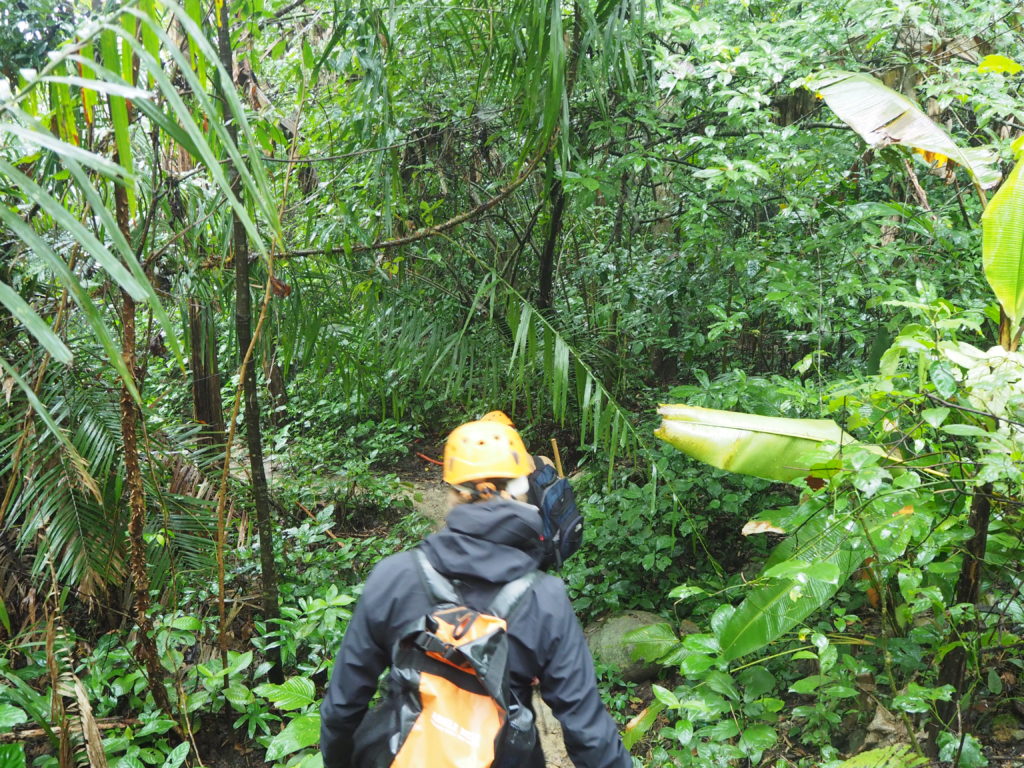
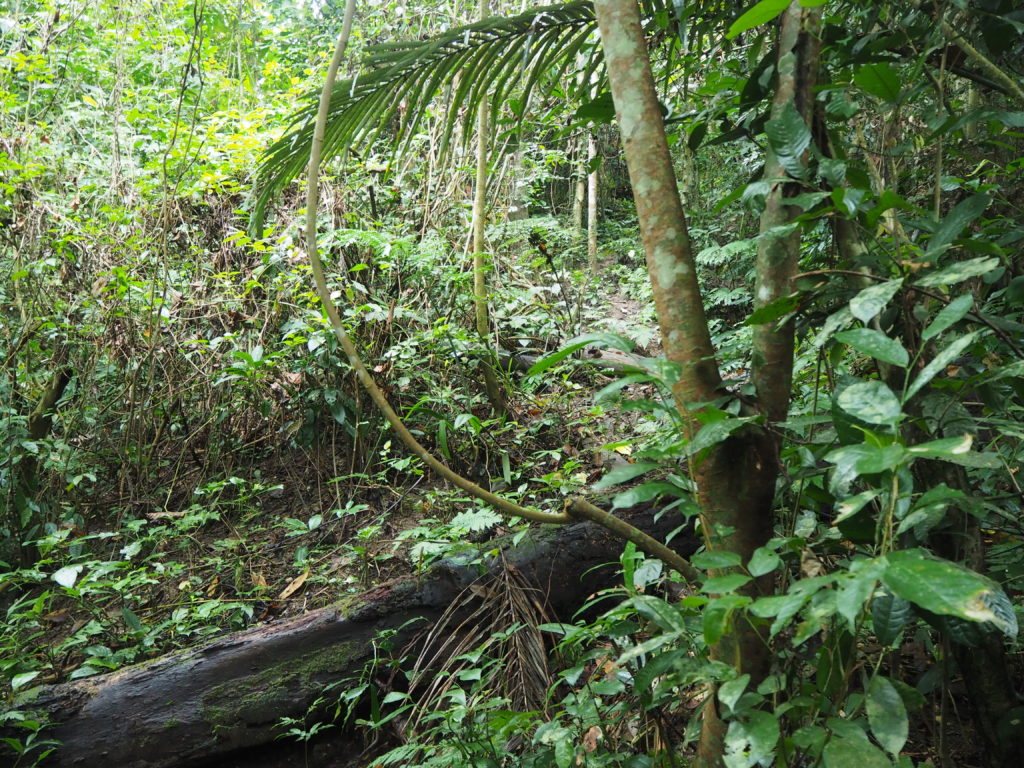

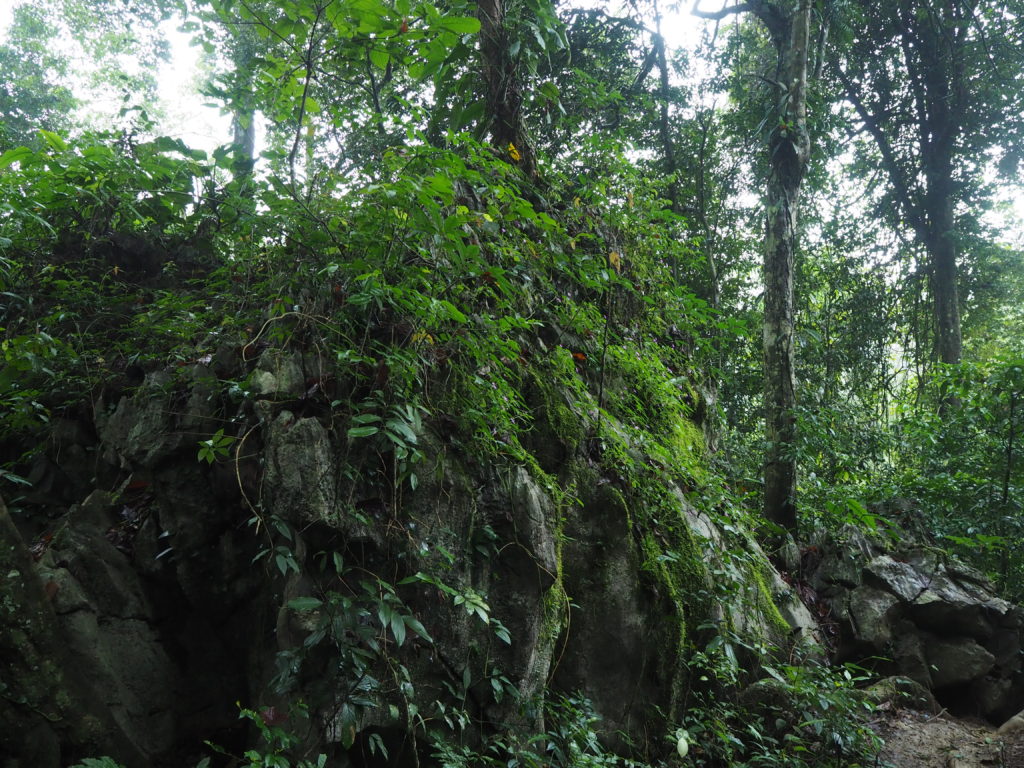
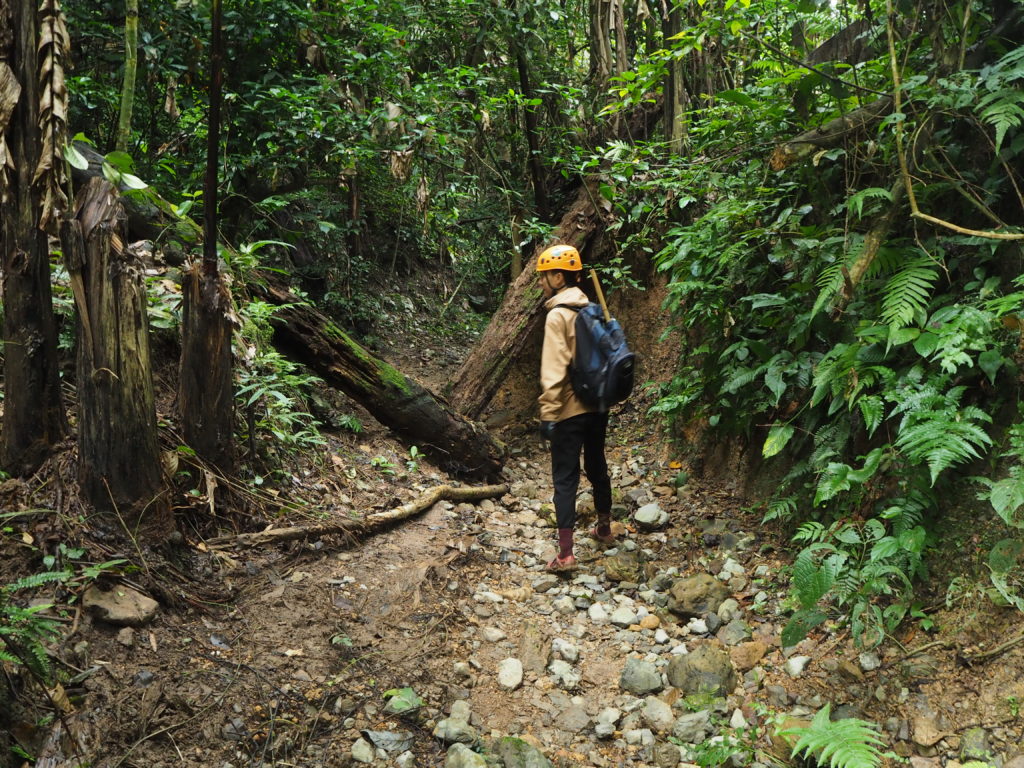
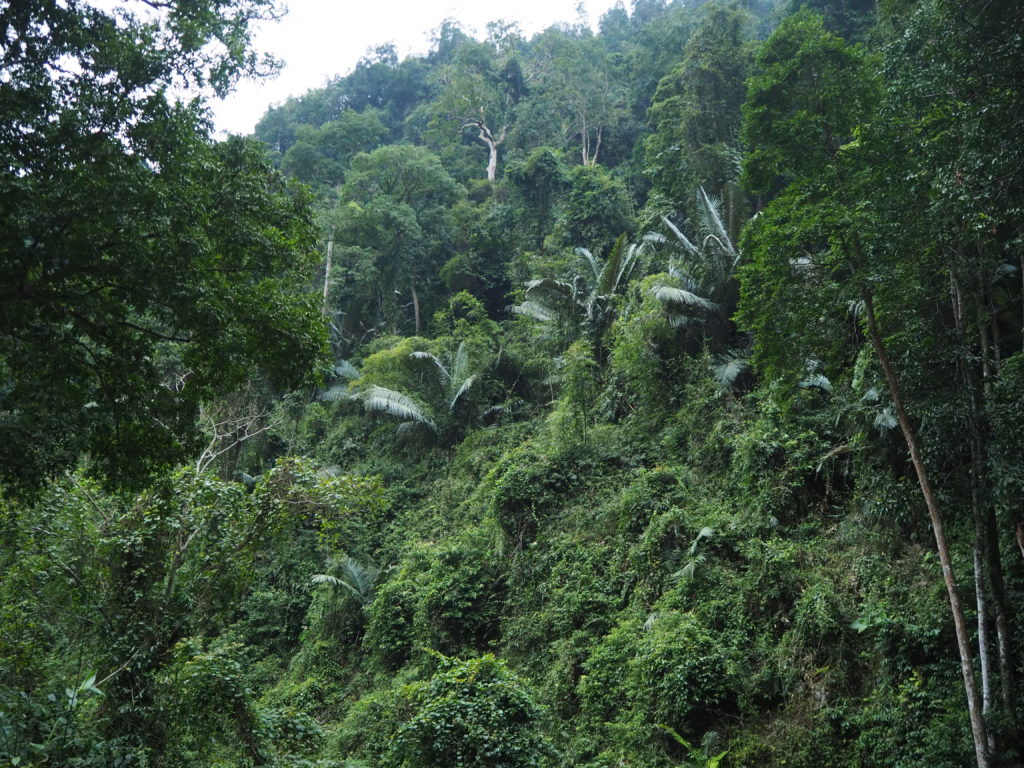
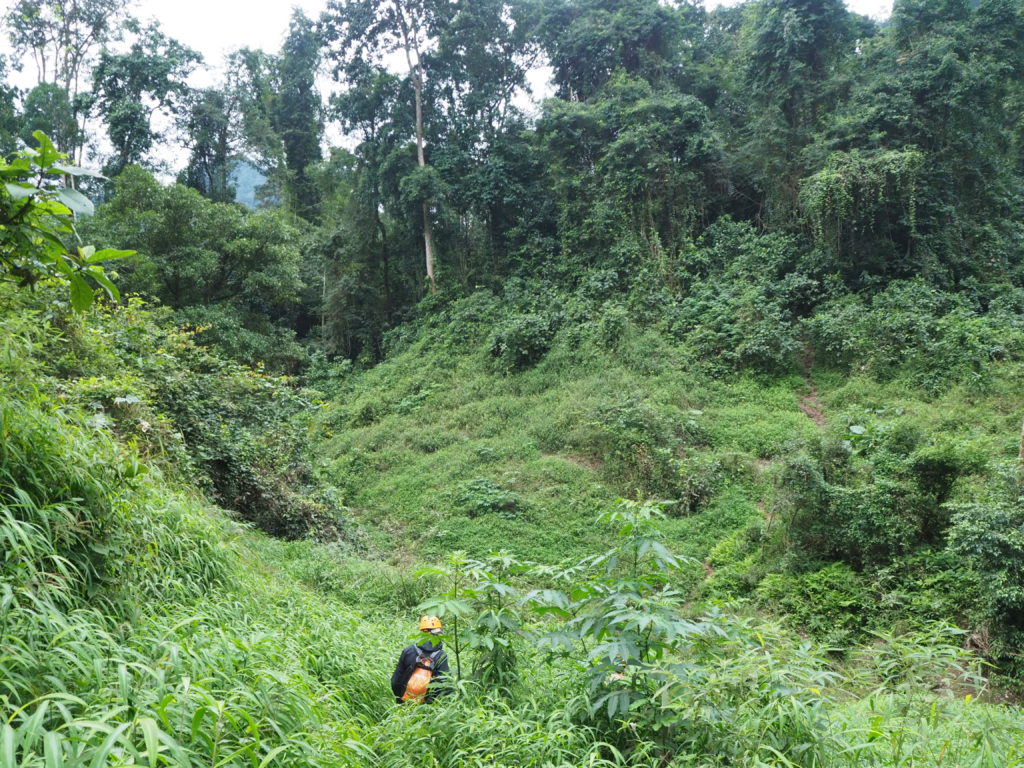

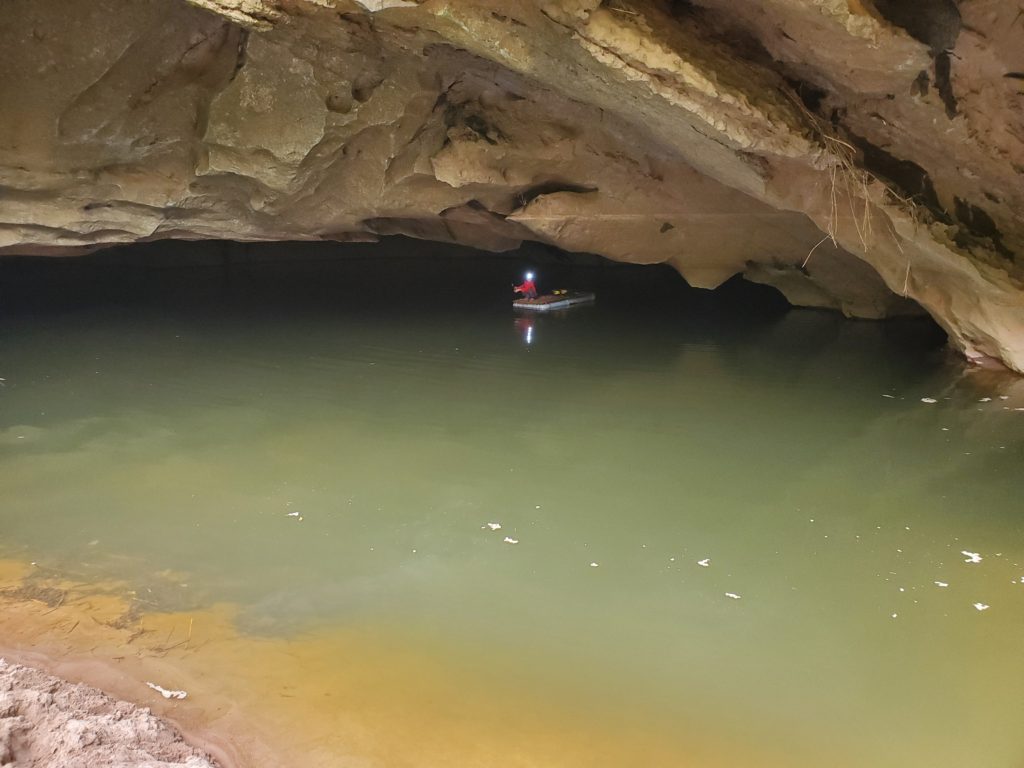
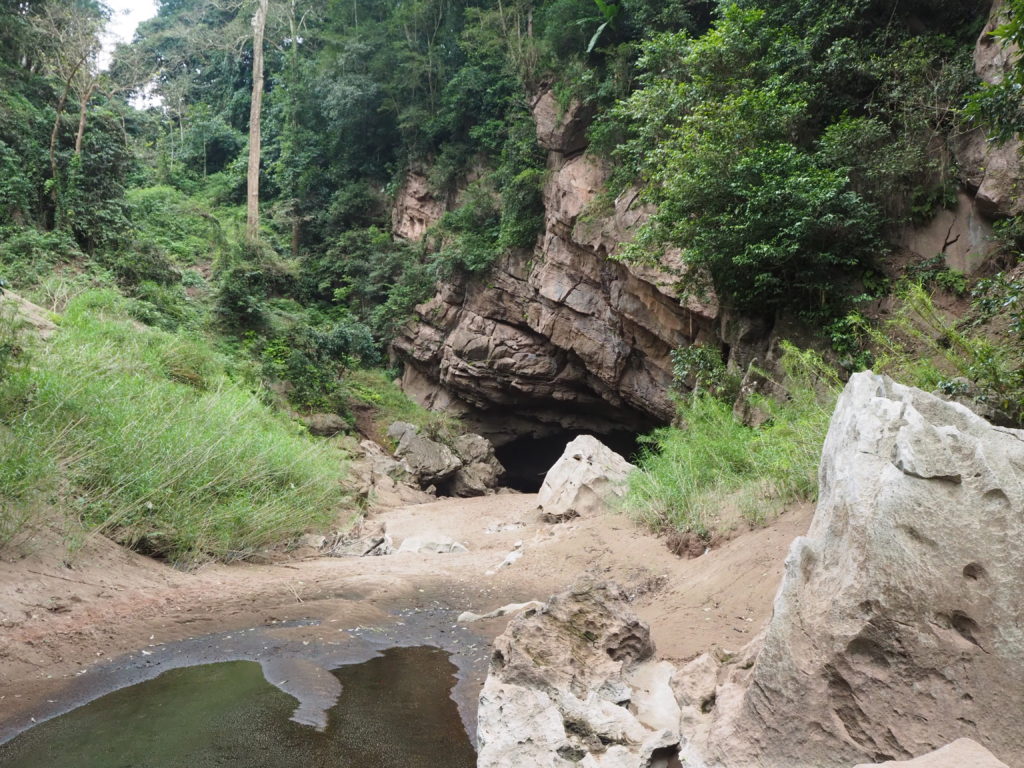
The cave was rather unassuming. We were on the sandy shore’s of the dry riverbed. In front of us below was somewhat of a beach. Some small fish came swimming by to say hello. The water had wooded debris, and some algae attached to it. Clear otherwise. Above us was a rocky cave entrance, framing the underground lake. We spent a while enjoying the view, and watching the fish, not really sure what came next. And then from behind a rock, from the darkness in the cave came one of the porters on a raft to ferry us through the cave to camp.
There were two options to get to camp now. We could raft. Or we could swim. We opted to swim.
Donning life jackets, head lamps and an uneasy spirit, we waded into the water, and into the darkness of Tiger Cave. The water was cold for Vietnam, but equated to an average lake in Canada. It got deep really quick. Apparently the water gets 5m deep or so in these channels. And it is also home to 5-10kg eels, which are worth a fortune at the market. As soon as it got dark, the water became crystal clear. You could see everything and nothing at the same time.
The chambers we swam through were quite large. Above us was 20-30m of open air. Our headlamps were strong enough to make out the triangular formations in the roof. Calcium formations that looked like gills would patch themselves onto the walls. Below us was only our legs, and then nothing. Not even eels. Cam, in her reluctance to acknowledge her current location and activity, swam slow, and was nudged by the raft to hurry up.
Before we swapped swimming chambers, Kong would shine a flashlight onto what untrained eyes would call unassuming rock, and tell us to swim there. And each time there was a hidden passage just behind the limestone folds, and another flooded massive room to explore. In all, we swam 300 meters until we saw light. One final pass through to the final room, and the other side of tiger cave. And the collapse.
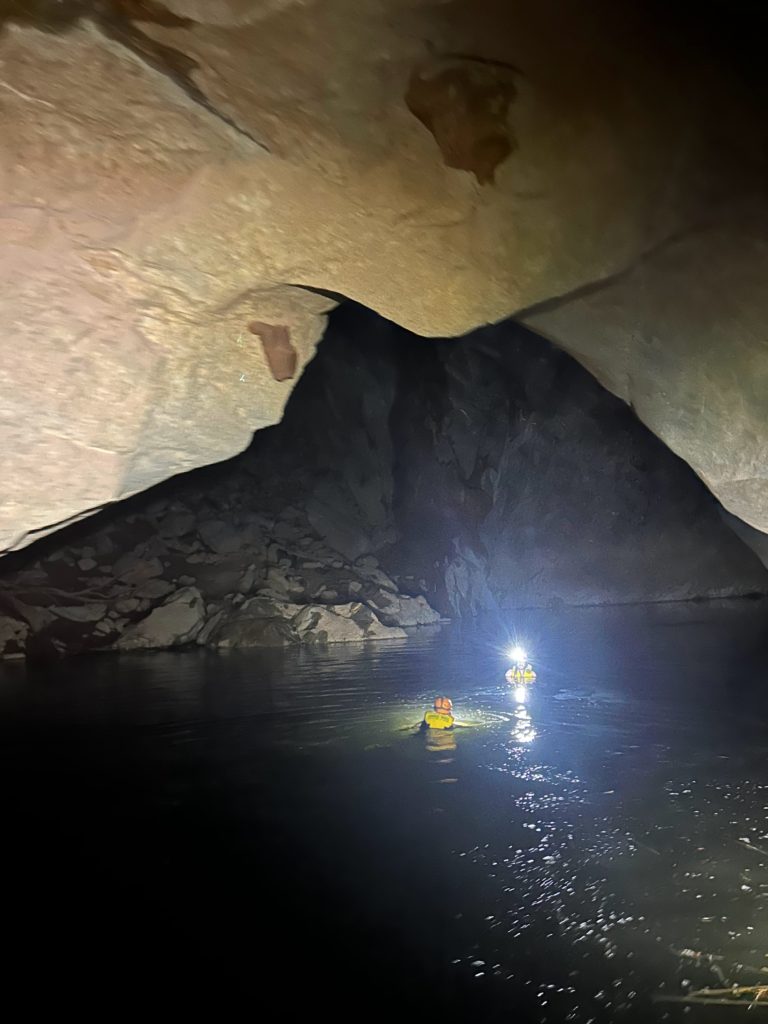
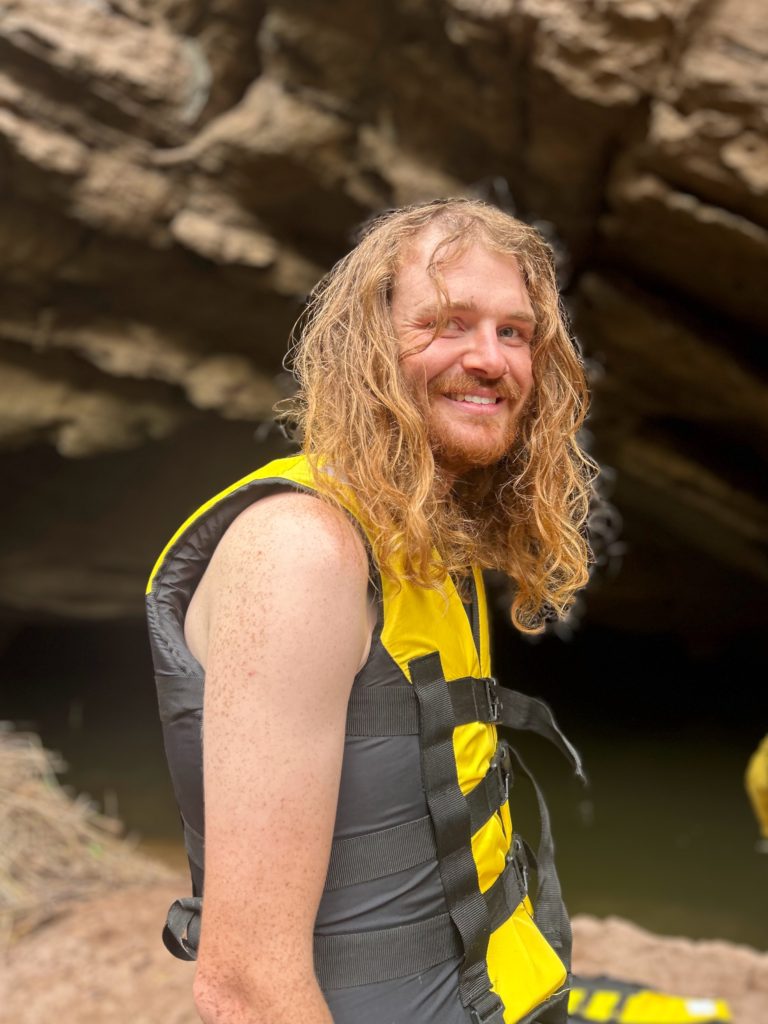
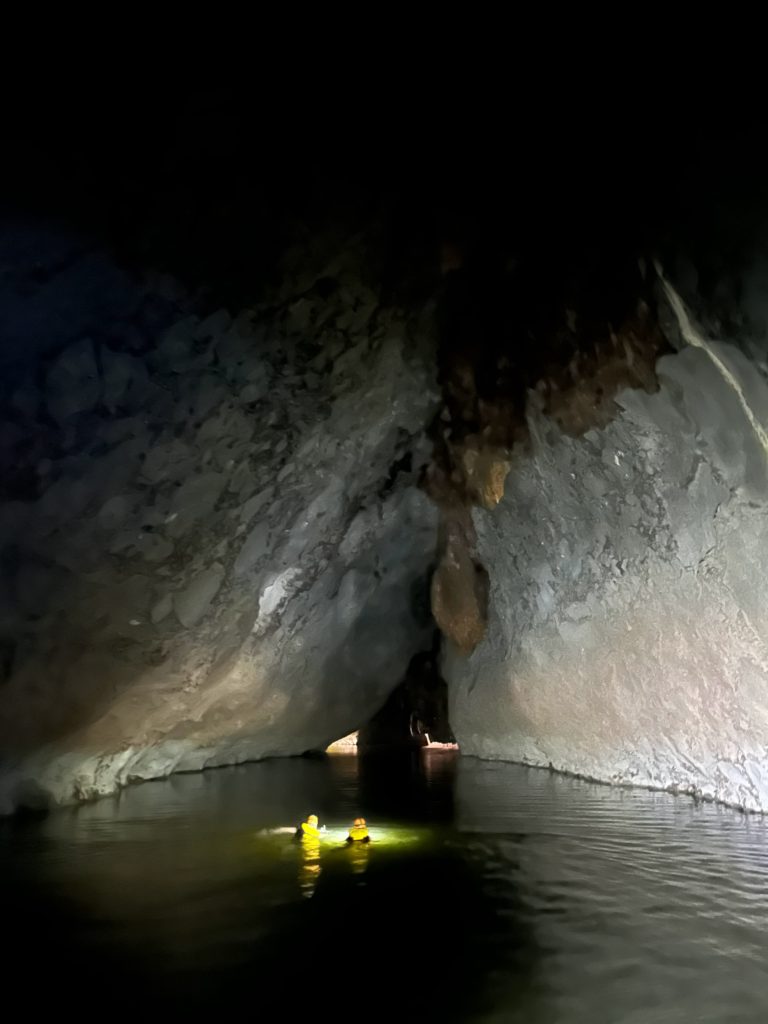
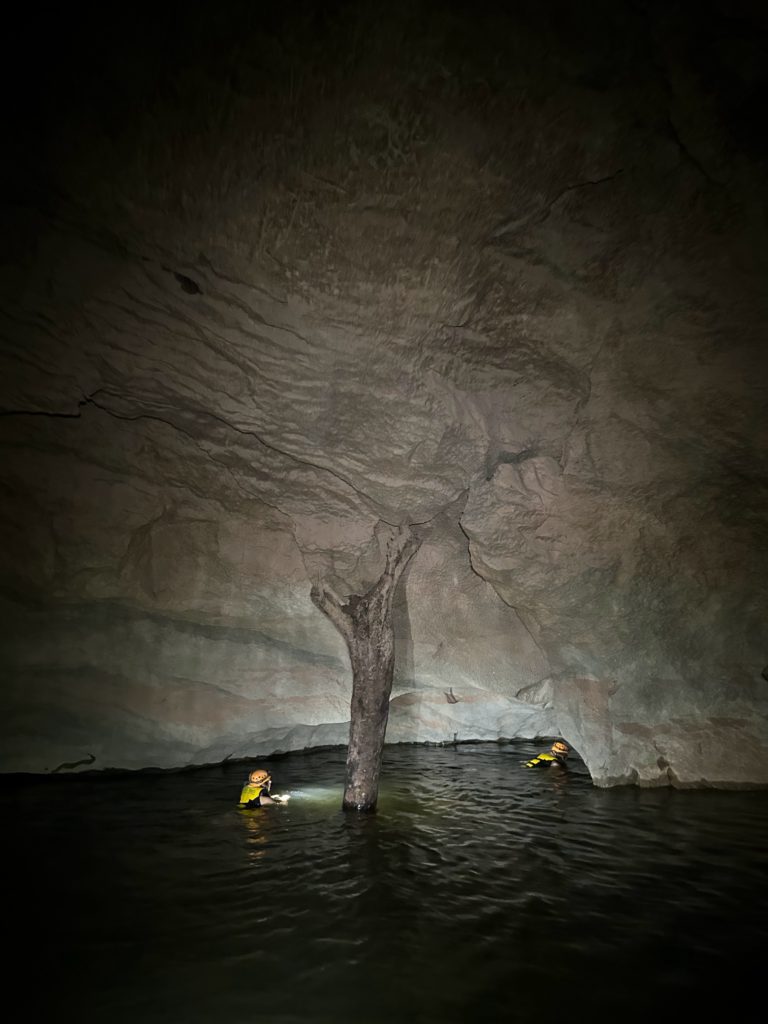
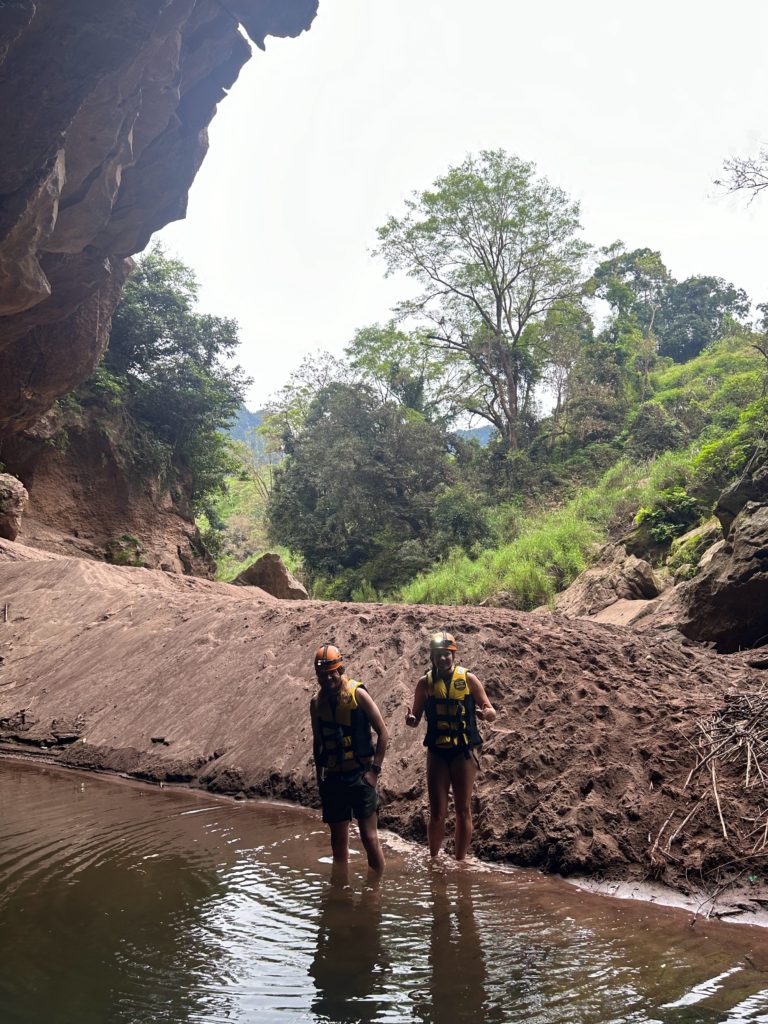
There’s not a more unique adventure feeling in the world than walking out of a cave lake onto a sandy shore, looking up, and seeing over 300m of rocky walls above you. We had made it to the Kong Collapse. To one side was a steep slope of jungle vegetation, which theoretically looked walkable out of, but was apparently not. And to the other three sides, were overhanging rocky walls. Different shades of rock occurred at different levels. Stalactites hanging on like long forgotten gargoyles. Some vines and moss making any rare sunny spot home. Wet patches where water was oozing out of the rock and into the lake. And piles of massive boulders that were remnants of the collapse event, which occurred roughly 2 million years ago.
The bottom of the collapse was a steep sandy slope, which was a brand new landscape for the collapse. Every year, this hole, and the rest of Phong Nha National Park, floods due to heavy rains and typhoons. Theses floods expand the caves ever so slightly when they arrive. And when they recede, they leave a whole new sandy terrain within the caves, collapses, and other lowlands that make up the region. We had a tent set up on one patch of flattened sand, which seemed open to everything, but still under a rocky roof, 200m up or so.
There’s small details that we noticed in the collapse. Like the one stalactite 100m up that would drip every 5 seconds or so, and you could watch that drip fall down for many seconds to the sand below. Or the grooves and circular holes in the rock that seemed like it would make a cool rock climbing route. It was quiet. It was just us. Cam remembers the spiders.
Dinner was unique. The eight of us had a family style meal, all sat upon a green tarp in the sand. Laid before us were large bowls of rice as a base. There was river fish from the region, dressed in eggplant. Beef with “forest vegetables,” (Morning glory). Egg and tofu as well. And a really really good chili onion fish sauce. We all devoured our food, and when we were done, the light had disappeared from the collapse. It was cloudy all day, so unfortunately no stars. Just a faint light from the stars and moon that separated the sky from the rock, directly above us.
We went to bed after sundown, and both agreed that this was the coolest place we have ever camped. Photo’s and videos cannot accurately show the collapse. It is simply too large, and the film just doesn’t have enough range. From the lakeshore to the top of the wall above it was 400m of rocky cliff. And again, it was all around us. A unique sight that is hard to find anywhere.
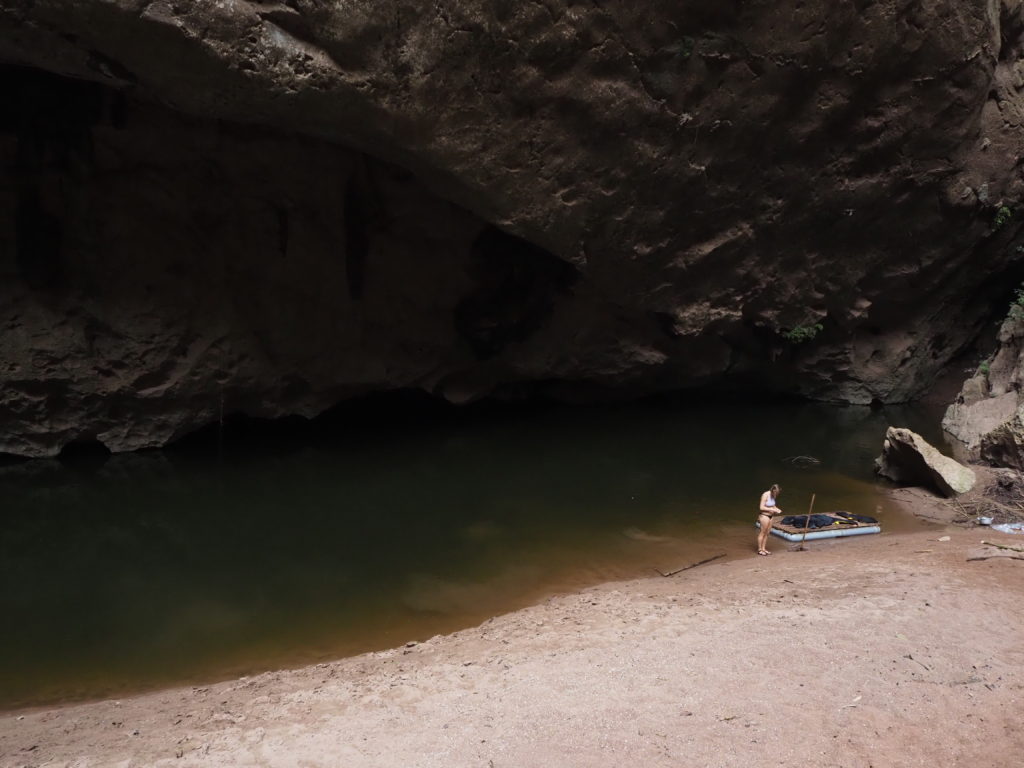
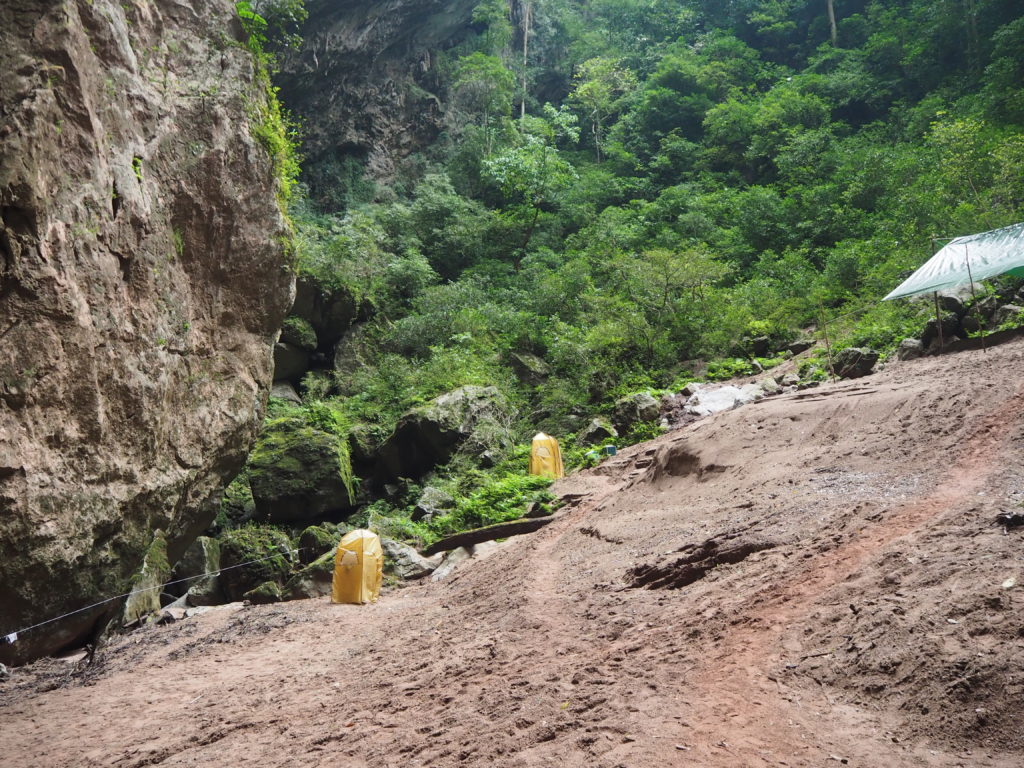
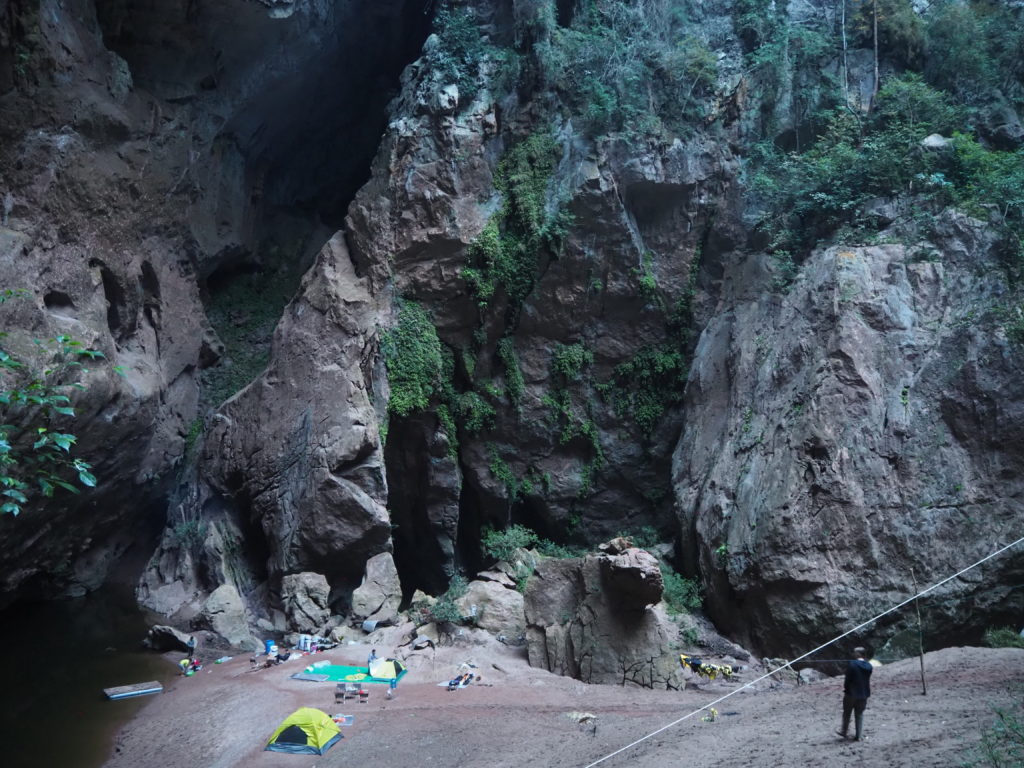
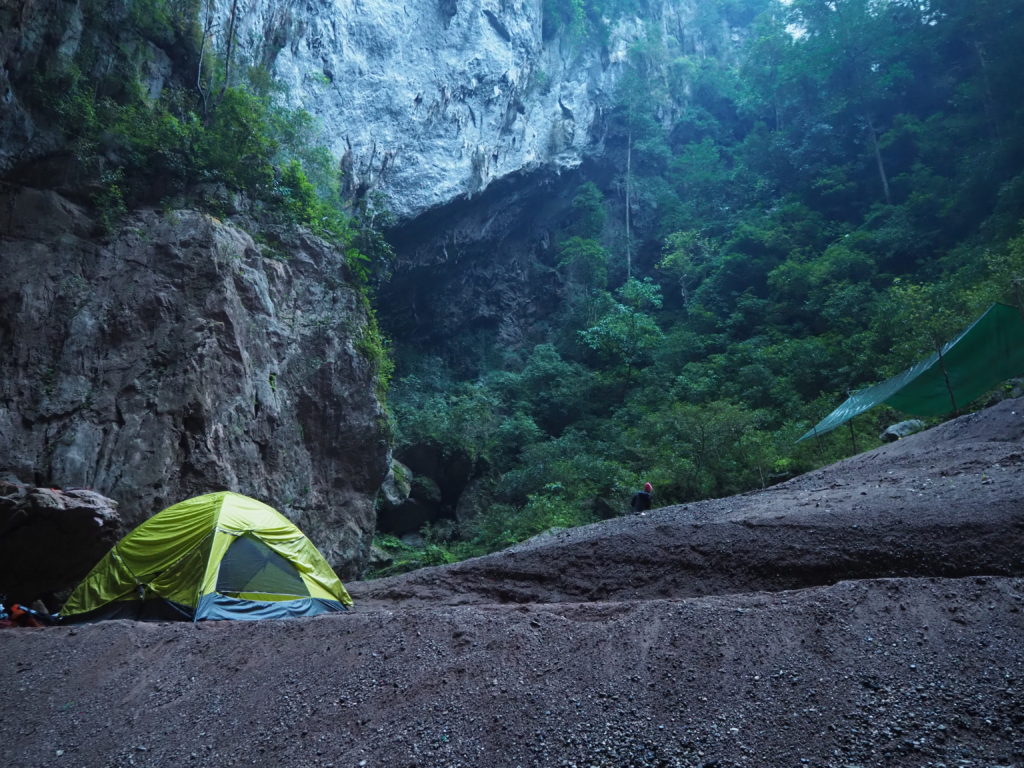
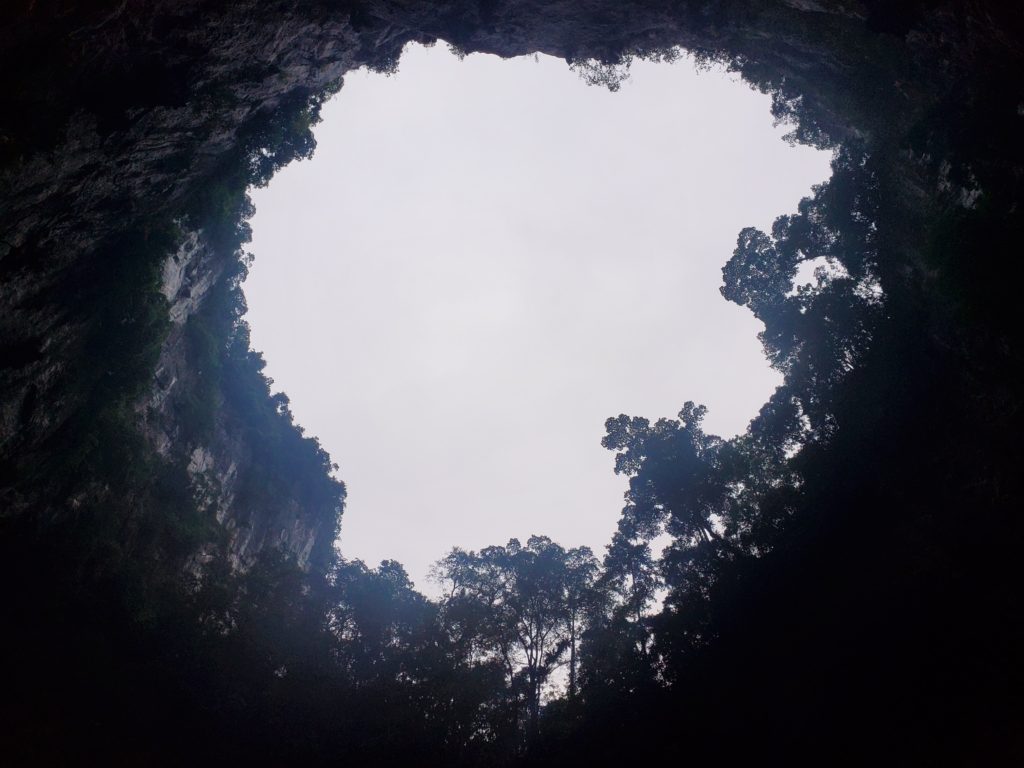


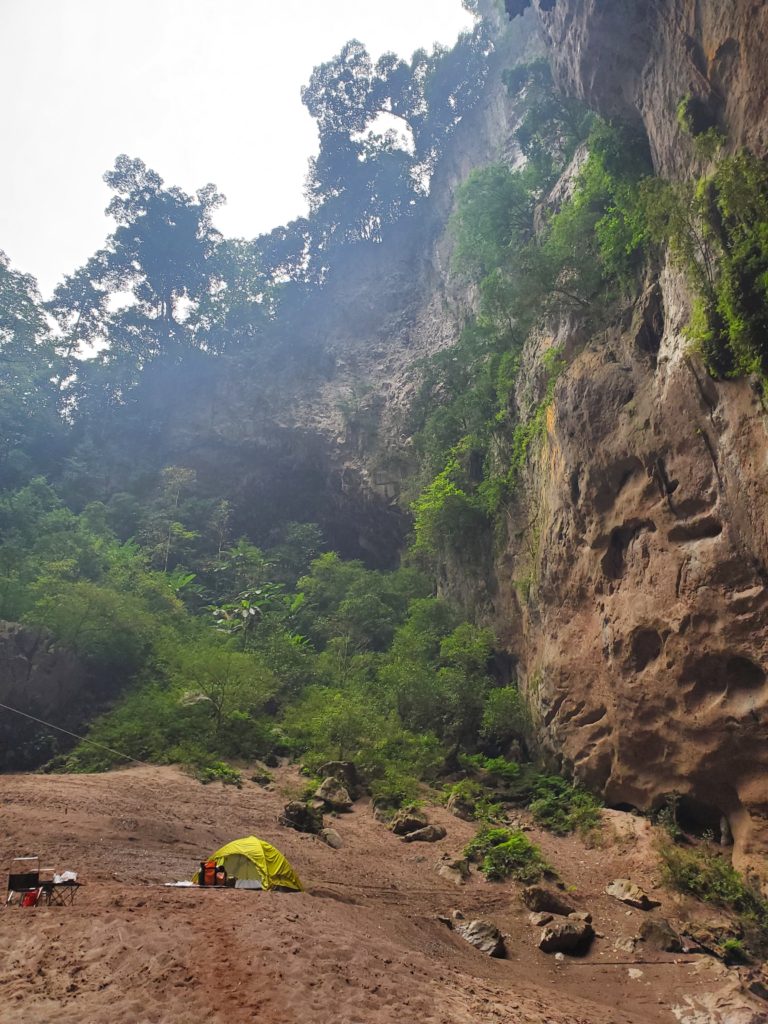
When we woke up, we still couldn’t quite believe where we were. The stalactites were still dripping. A frog was croaking. It was all so still. We had some pho for breakfast, and then observed our rocky prison for a while longer. Then we began the insanity that was Day 2.
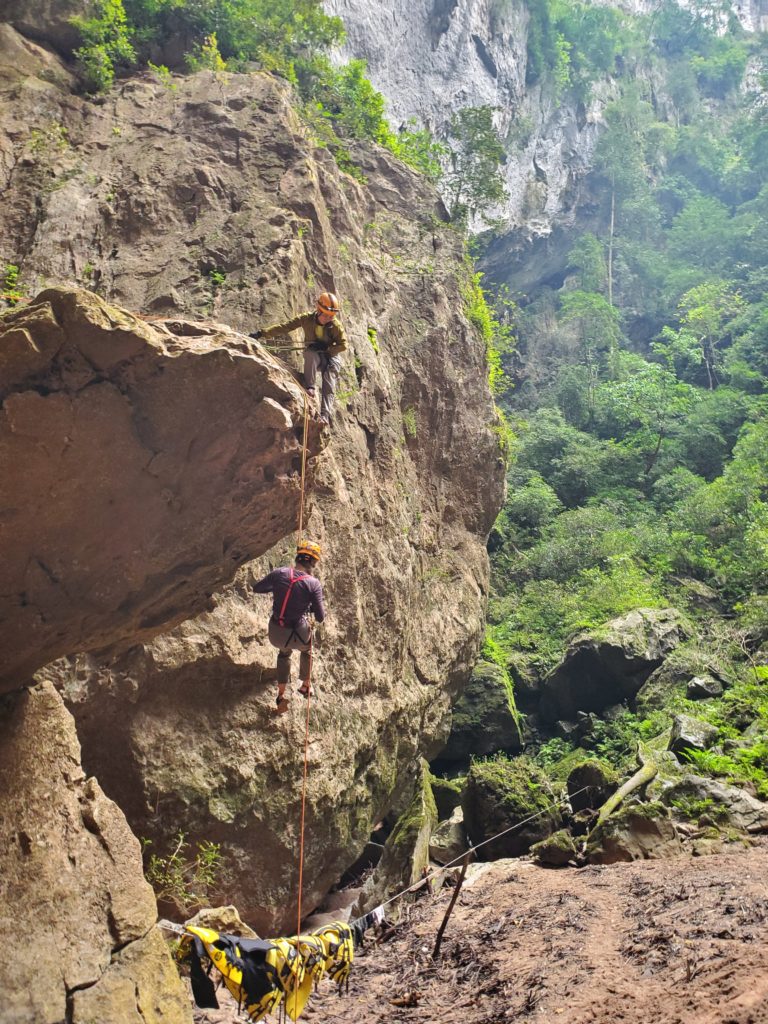
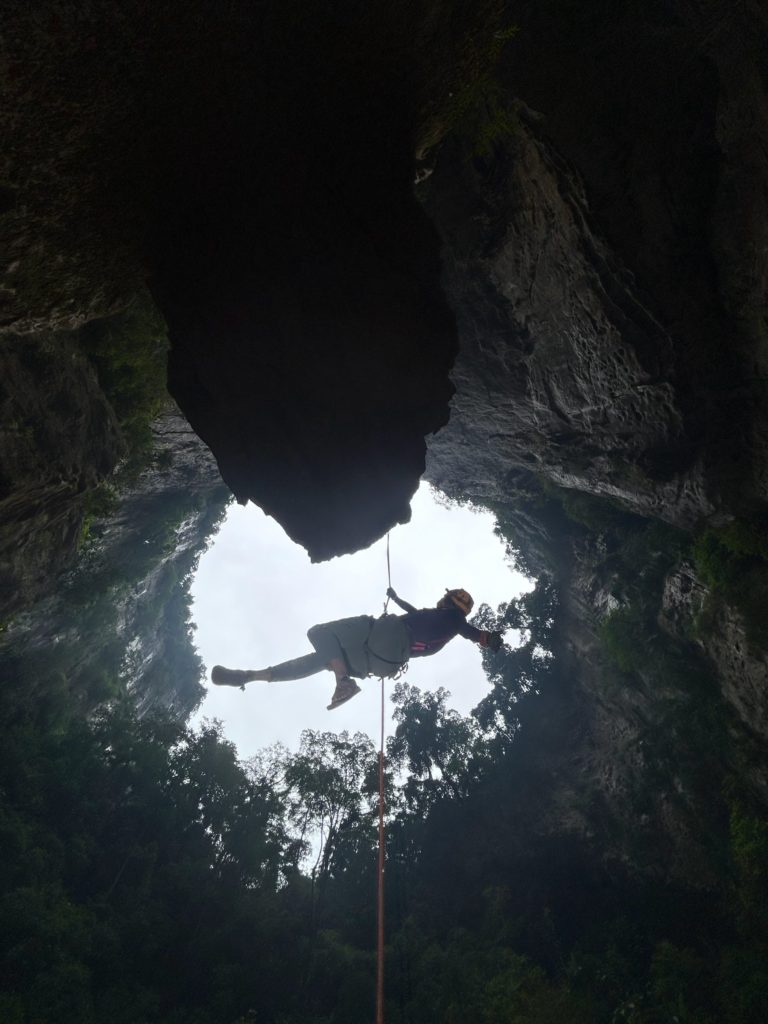
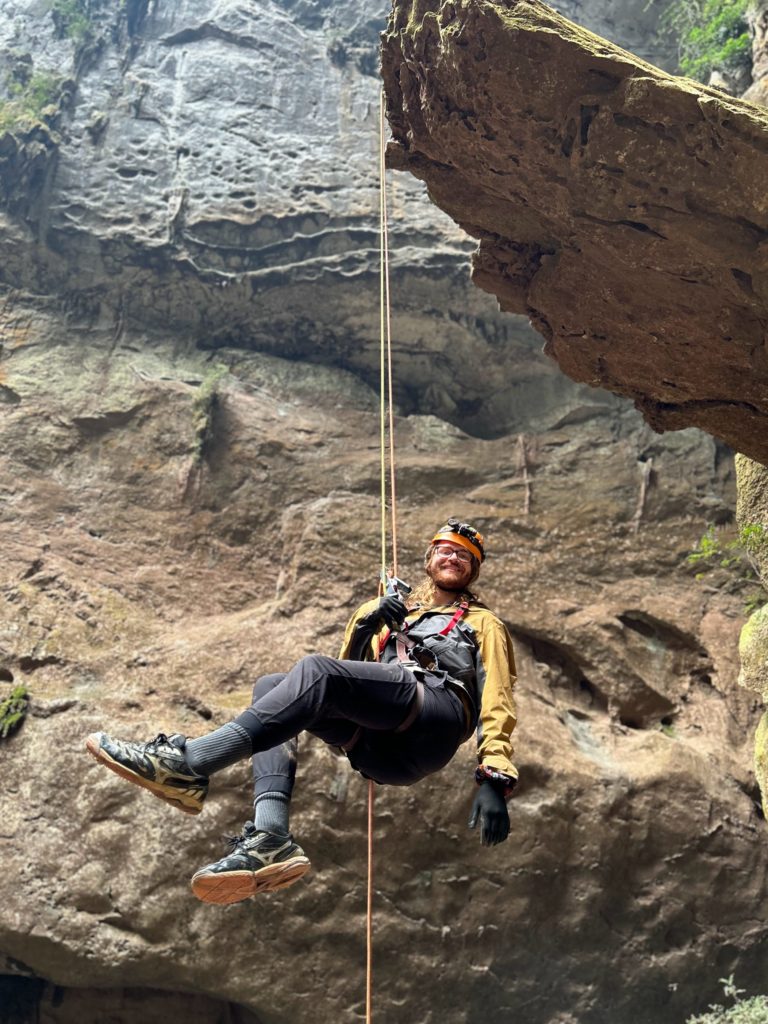
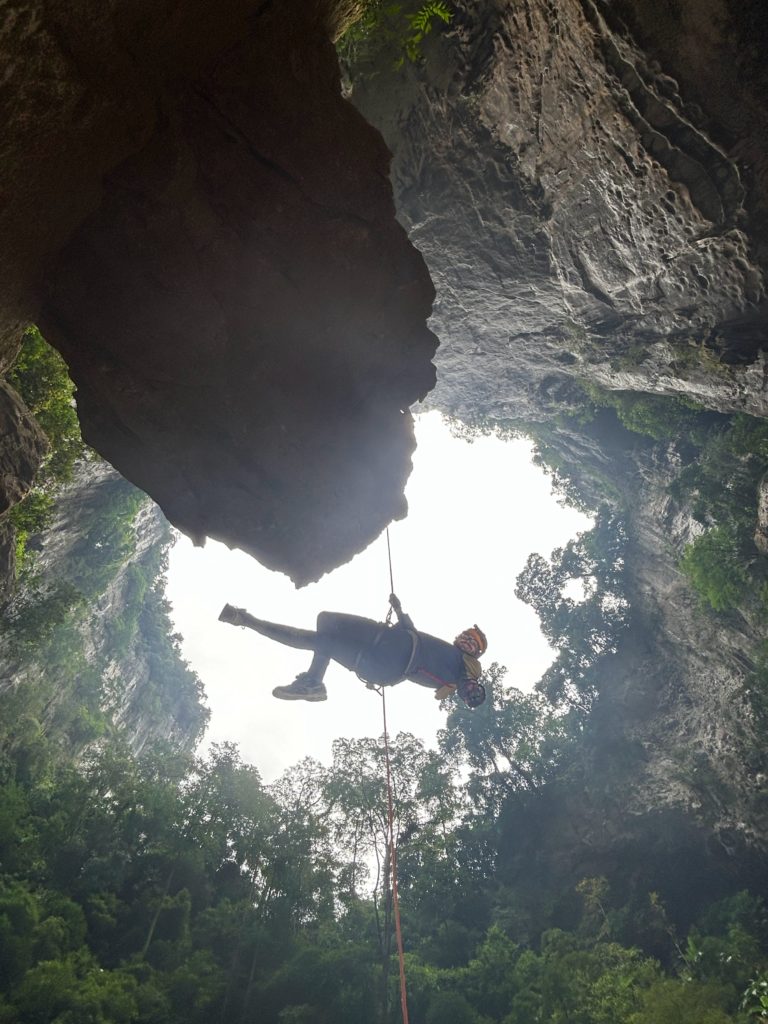
It starts simply. We would abseil (repel) off of a 10m rock that was located within the collapse. 10m is a large rock, and it was a large overhang. But your sense of scale is warped in the collapse. It’s just too big to comprehend. Kong took some cool photos, and then the real journey started. Back into the tiger cave, this time through a different entrance. We had 15 minutes of crawling around, before we made it to the river. Underground river.
The crawling caving was claustrophobic and not very fun. It’s a good thing we had helmets on, cause we kept hitting our head. Sometimes I would look up, and Kong will have disappeared. I would call out, and his headlamp light would peek out from a boulder, highlighting the completely unobvious next step that we were taking.
Tiger Cave was first explored in 1997. It had been known to the indigenous population for a long time, but they believed that monsters resided in it (and all the other caves around), so they did not wander into them. I don’t blame them. It was an American led expedition that first explored the cave. But it still took them 22 years to find the collapse, which was discovered by the tour company owner by flying a drone over the region.
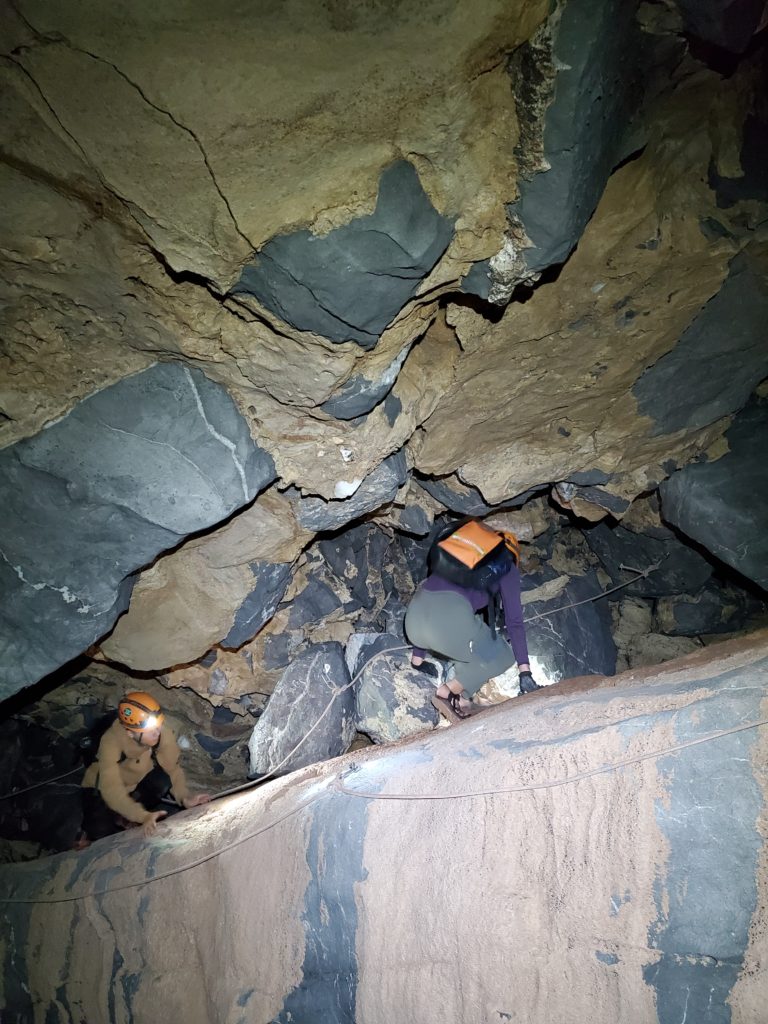
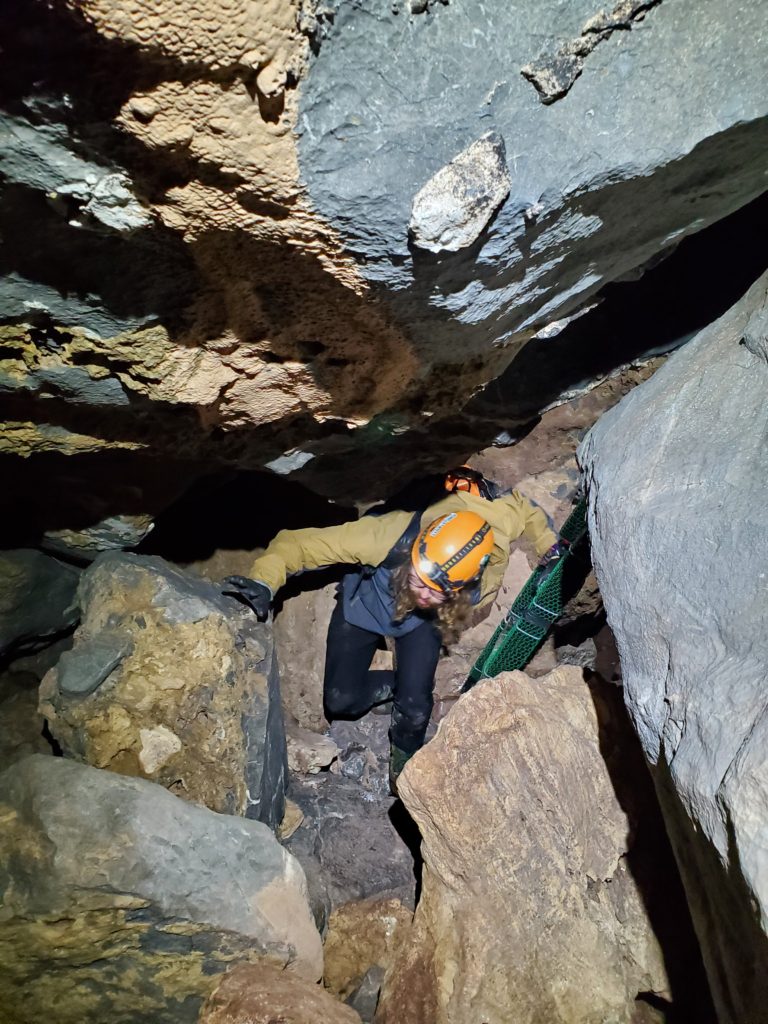
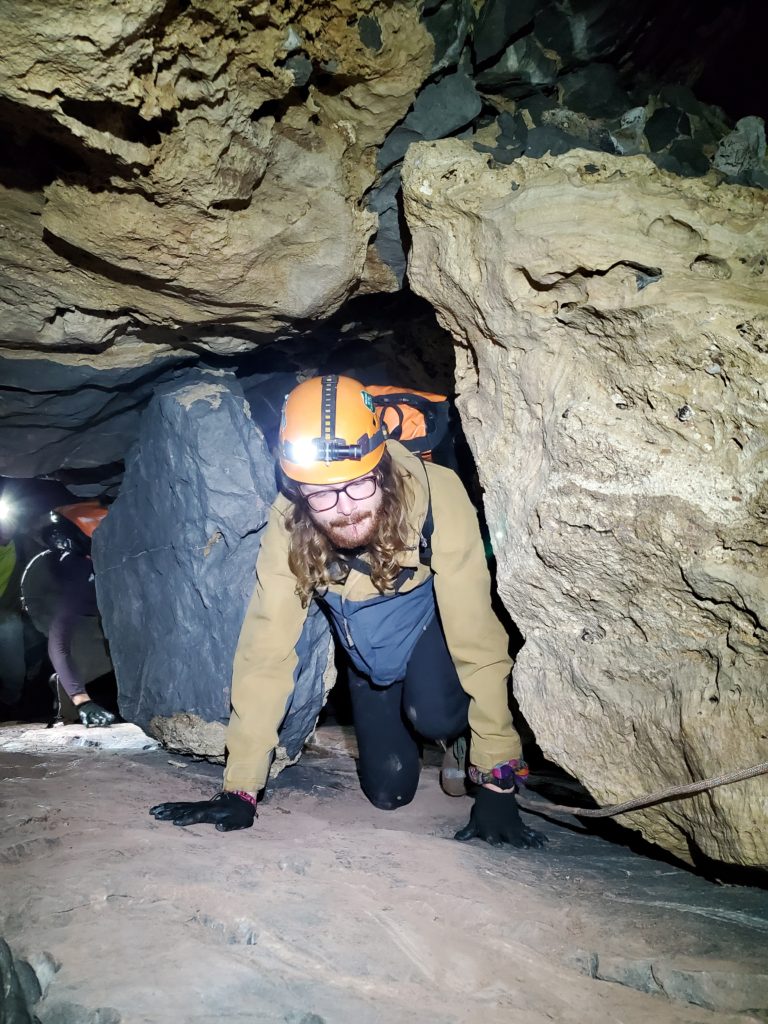
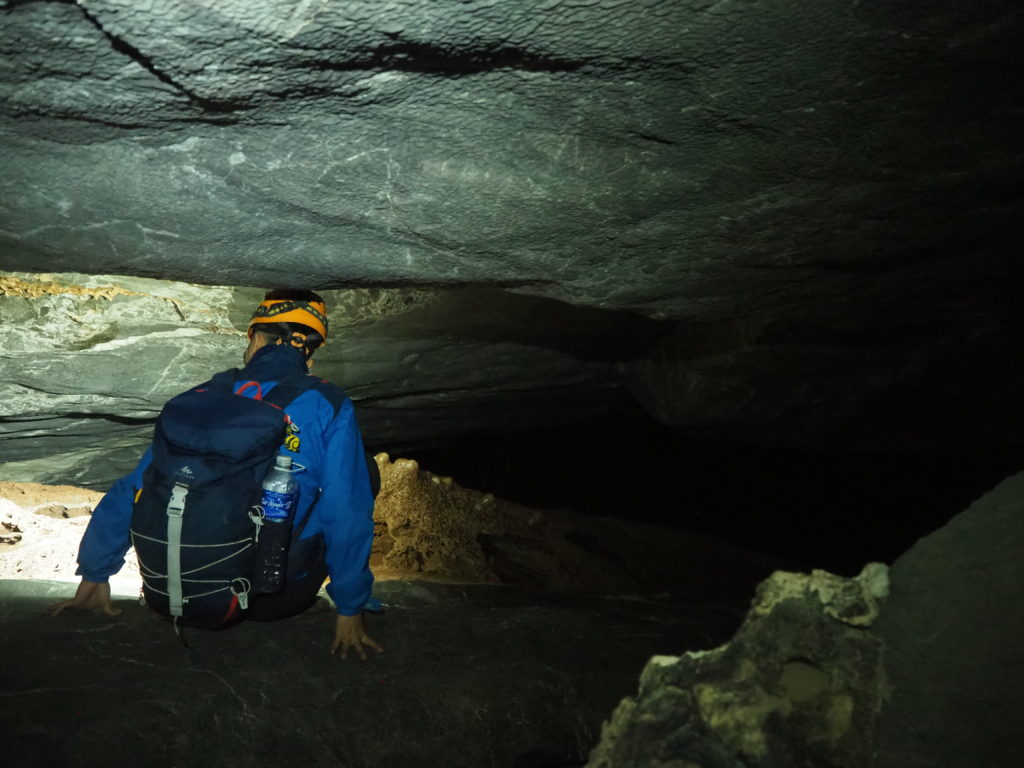

After way too long, we made it to somewhere we could stand, the banks of the underground river. Still pitch black, except for the headlamps of the five of us. The three porters were going above ground to the entrance of Pygmy cave, which would be our campsite for the night. We had an optional swimming excursion to the third Tiger Cave entrance, which we decided to take.
The river was clearly separate from the original lake that we swam in, because it was much colder. King decided to join us for this one, taking a small raft with him to keep his upper half out of the water. He was training to be a guide, but frequently stopped for pictures, clearly still in wonder of what would become his future job. This swim was quicker due to the cold. We inspected the walls of the cave, which would plunge into the depths of the water. There was no simple rhyme or reason to the depth of the river.
The entrance was very pretty. As we rounded a corner, we came ashore and saw a small hole of sunlight and green. A reprieve from the white light we were used to. As we got closer though, well, the entrance got bigger. As we looked out of it, we could see how easily it could be missed. A little creek flowed out of the cave and into the underbrush of the jungle. The foliage covered everything around the entrance. A massive opening to the underground covered by the greenery.
We swam back the way we came, back into the darkness. We had another 1.5km in the Tiger Cave, again the first of three we would maneuver through today. We got used to the cold water after a while. The air in the cave was warm, but not overly hot. Right in that annoying spot where its too cold if your sedentary with no jacket, but too hot when moving with one.
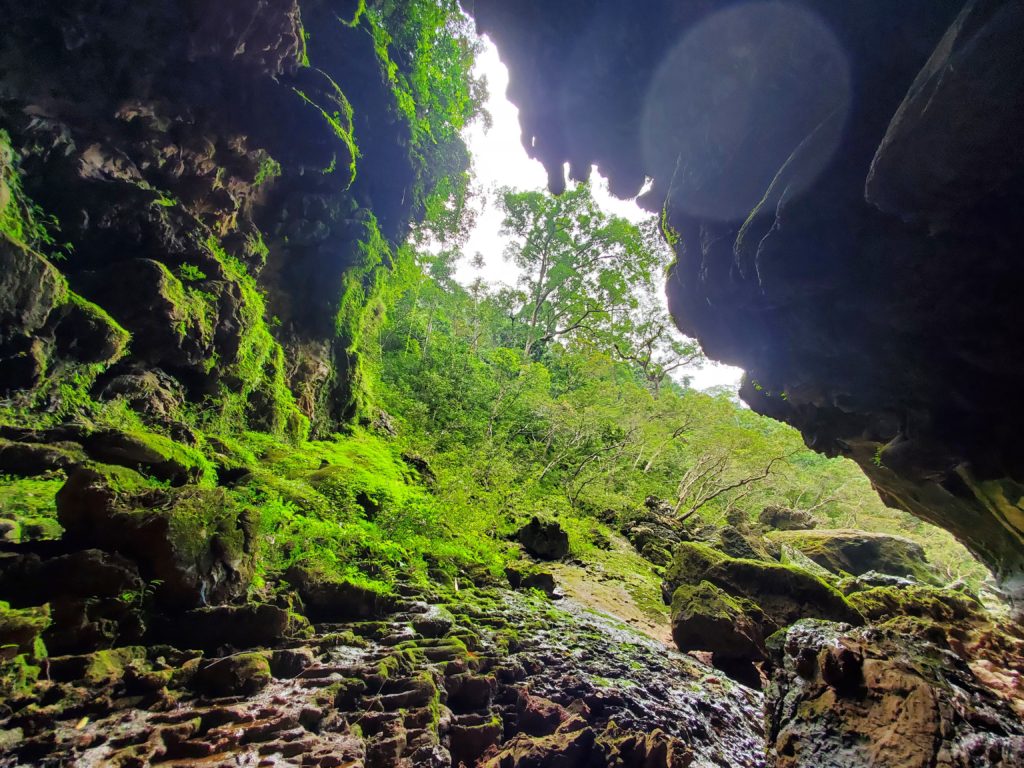


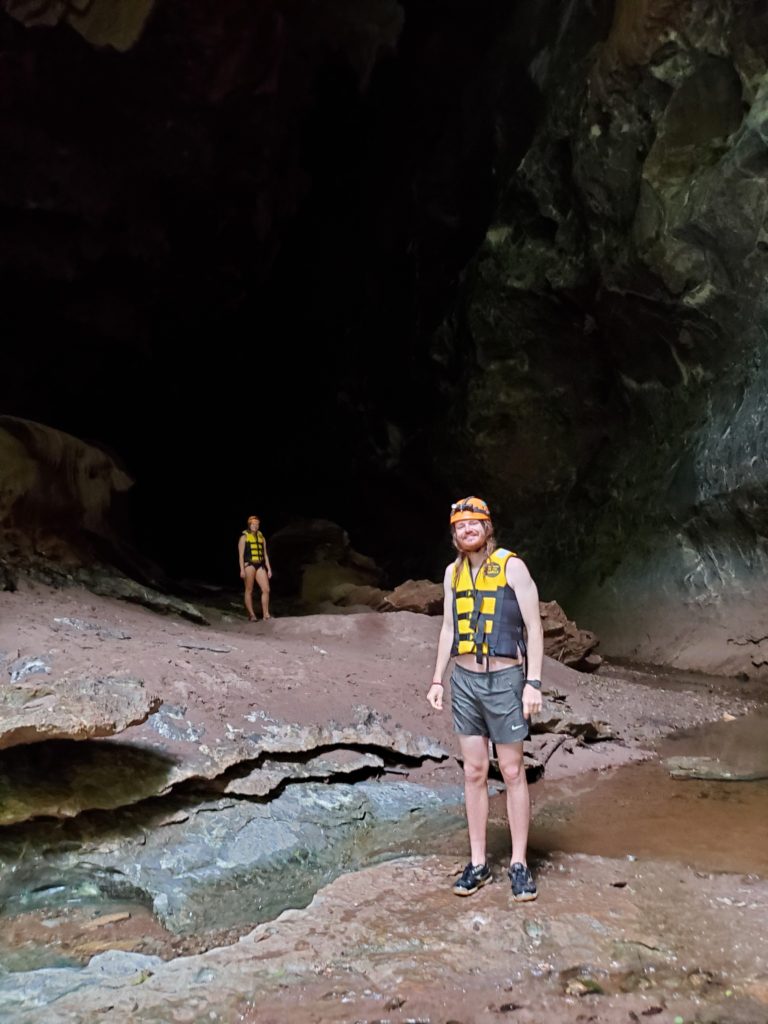


Now fully in the dry cave, with room to move around, we could finally take in all of the geological calcite cave features that awaited us. There’s the obvious stalactites and stalagmites, and the columns that come between them. But there’s many more formations, there’s flowstone, where the calcite falls over a ledge like a waterfall frozen in time. Or calcite pools (rimstone dams), which make up many baths, usually layered on top of each other. Sometimes full of water, sometimes dry. Observing all of these was really cool. Nothing like any of them appear naturally where sunlight occurs.
We couldn’t enjoy the formations for long, as we had a narrow passage to get through to escape Tiger Cave. There were two options, the lower route, where we would get our shoes wet, or the upper one, where we would walk along the edge of calcite pools to the other side. We opted for upper. The first pool was full, so we carefully leaned over it, opting for a potential accident into the pool over falling into the darkness. The second was empty, and we made it our home, hanging out with a frog before exiting. No idea what the frog was doing this far into the cave.
Finally daylight, but it was far away. Between us an the perceptively small slit of light ahead was a massive field of boulders. All rocks that had fallen from the ceiling after millennia of floods and erosion. Every hundreds of years or so another falls from the top, and eventually, the whole thing will collapse as well. As we got closer to the entrance, it got larger, and the boulders got greener. More moss and lichen growing on the rocks. Survivors of the flood, surviving off of the smallest amounts of light that enter the tunnel.
We were slow heading out of the cave. But we made it. The entrance wasn’t all that small. It was at least 20m high above us, and at least 100m wide from end to end. It was here that the tigers called home, and if we dared to venture up the side of the cave (we didn’t) we could see the remains of their meals decades ago. The entrance was again a mass coverage of rocks and foliage. It sharply ascended, as we climbed on top of what was previous the caves roof.

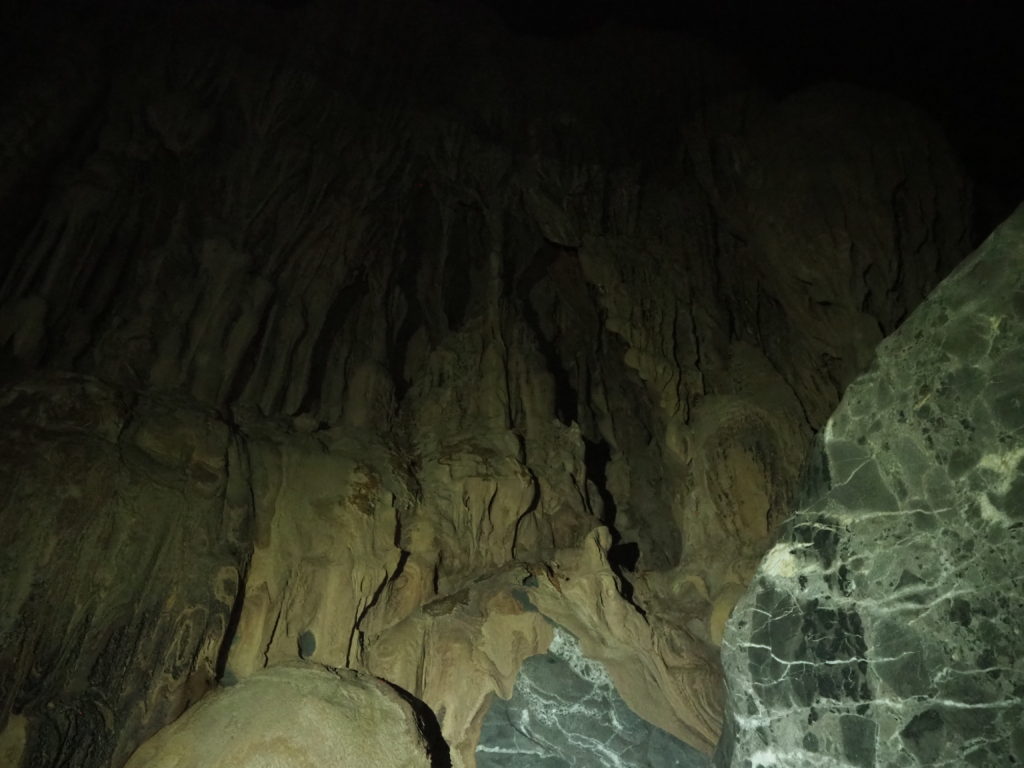
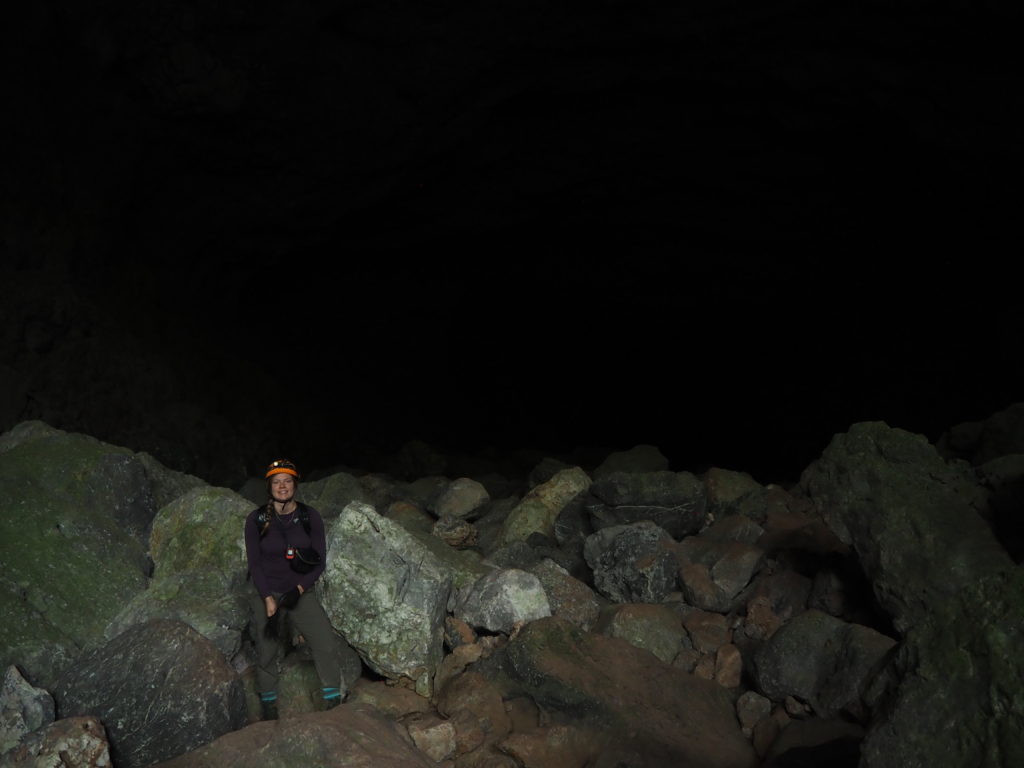
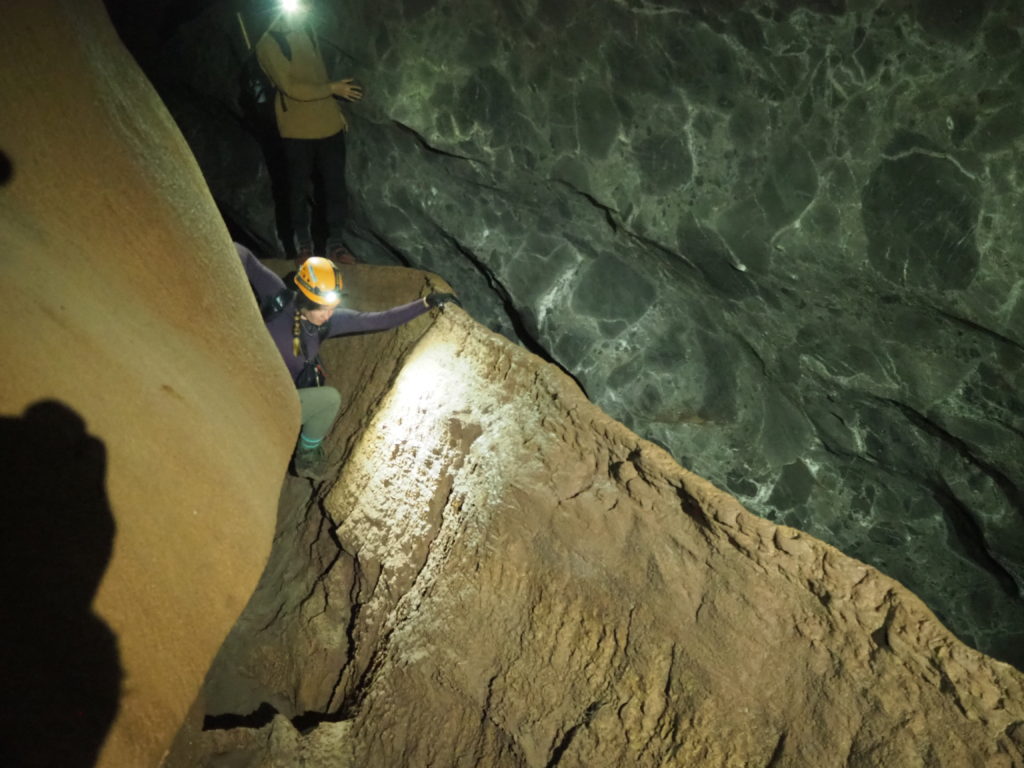
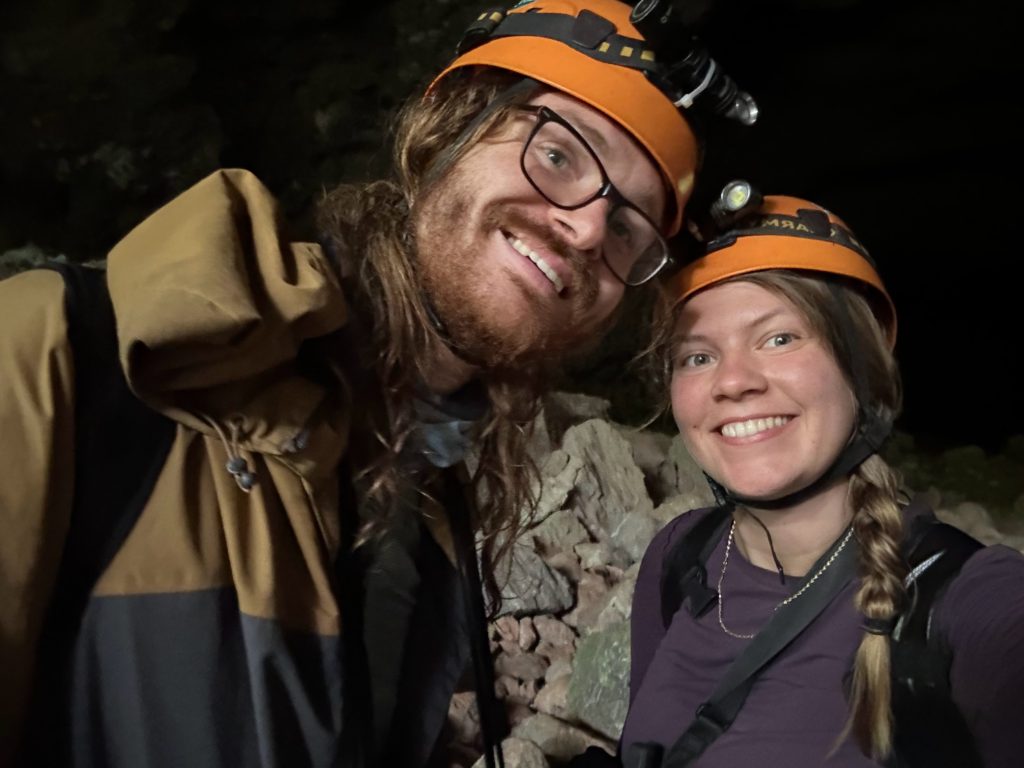
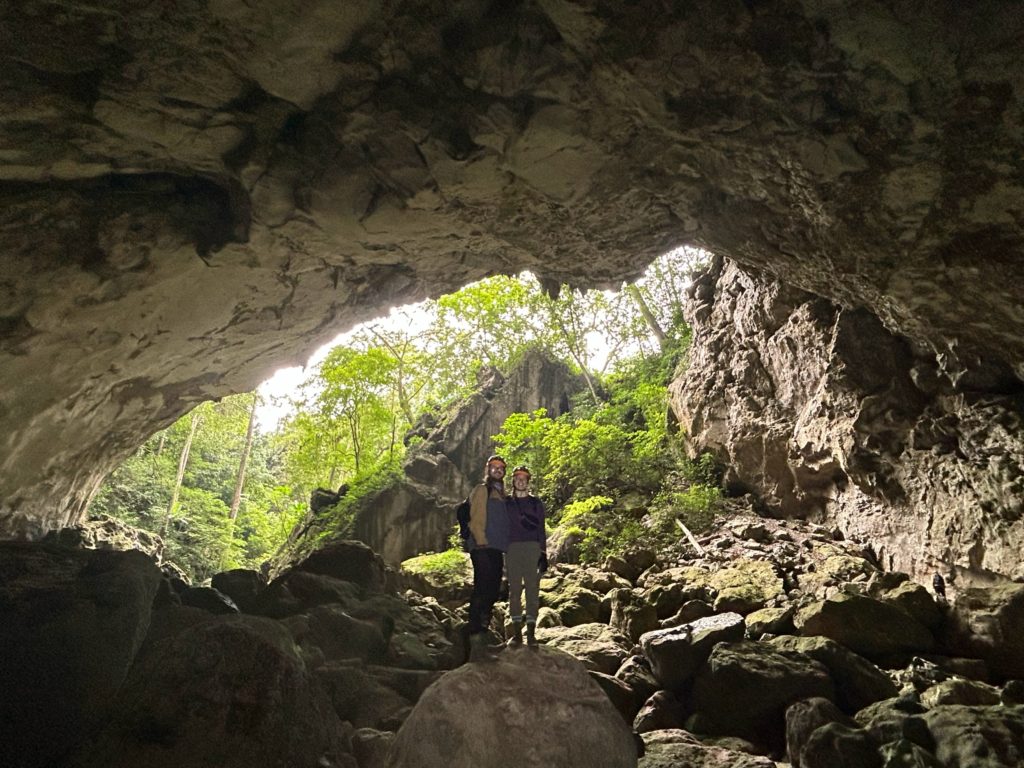
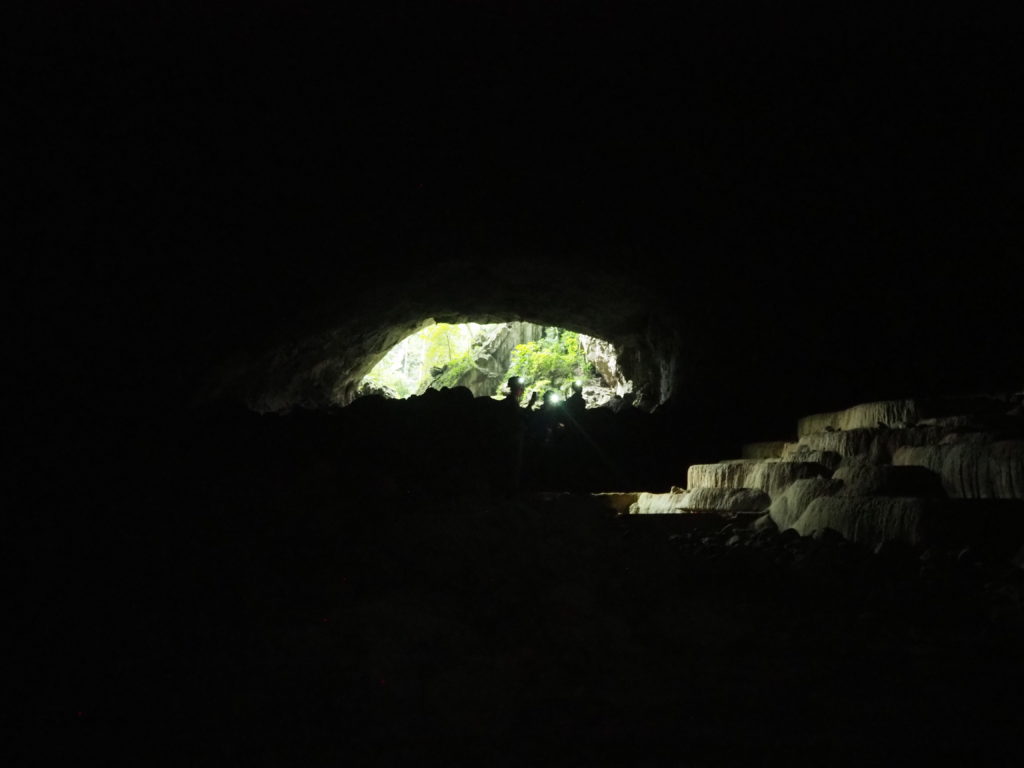
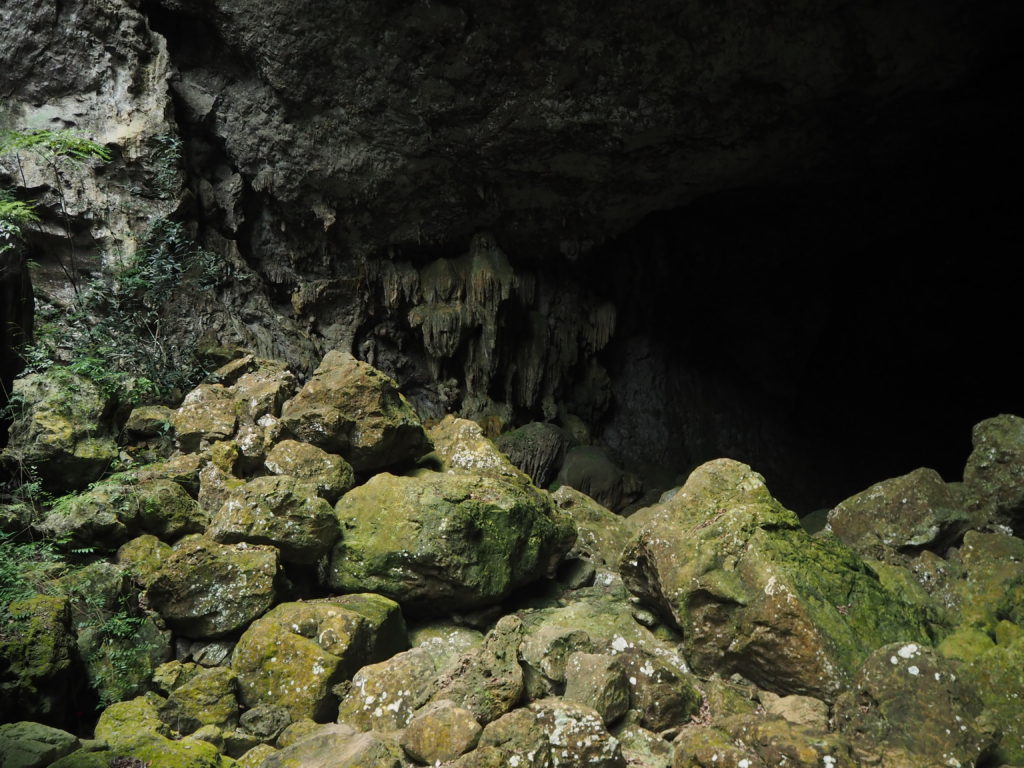
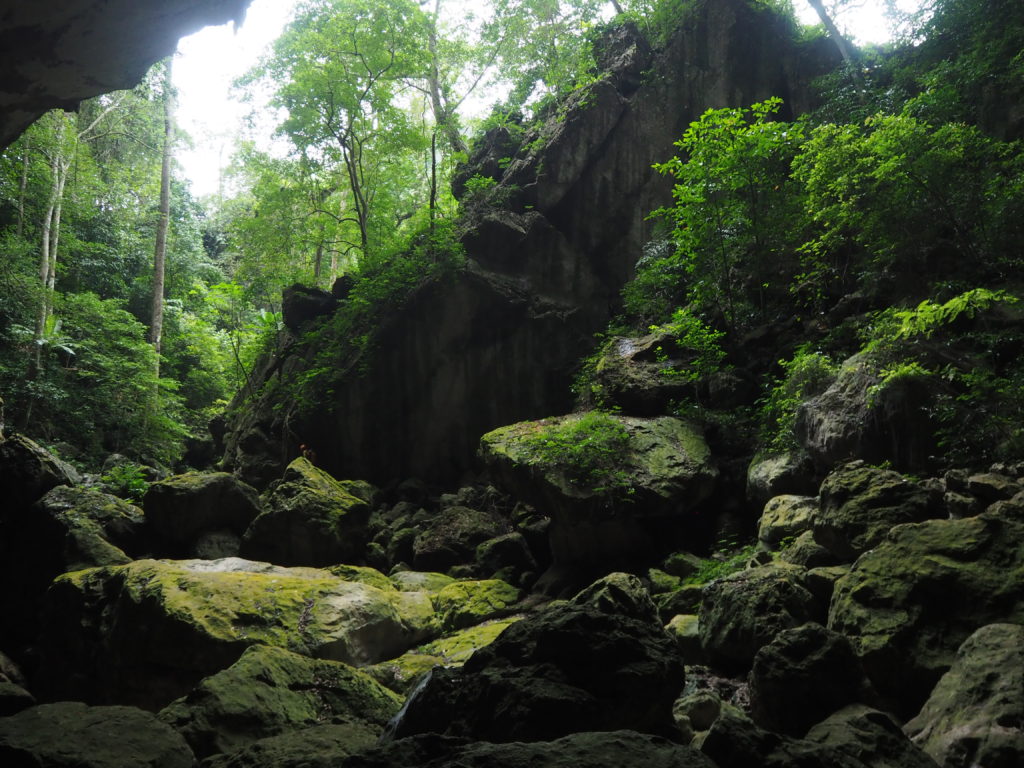



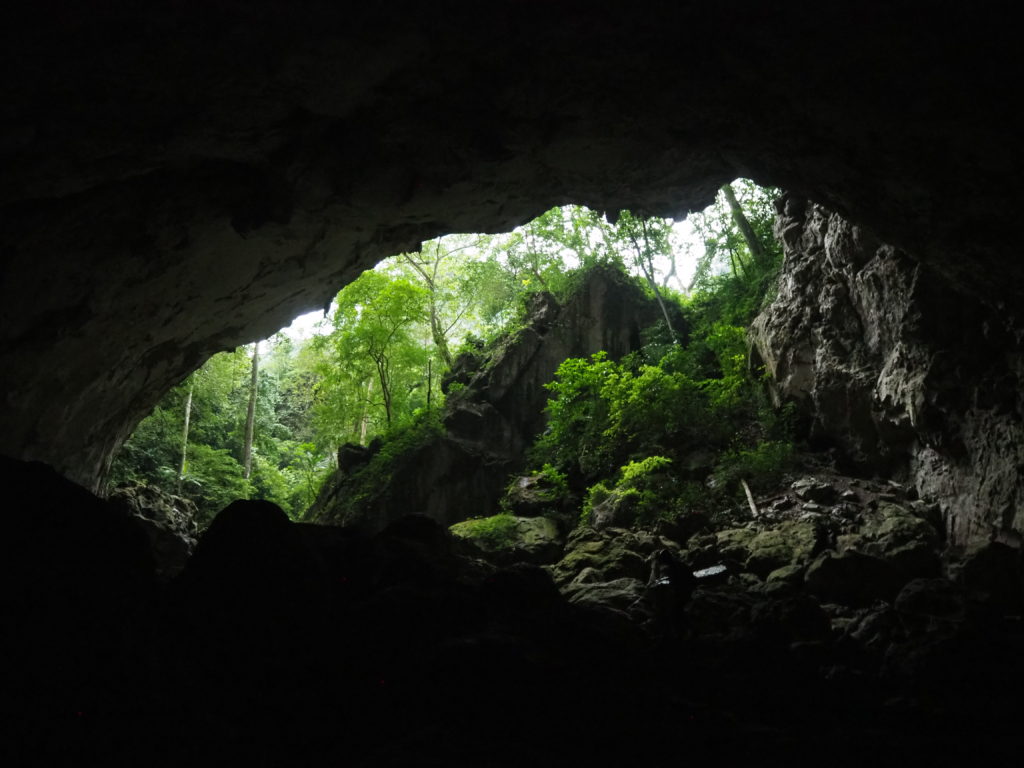
Back into the jungle we went. This section wasn’t so much a collapse, but a depression. There was a collapse here for sure, Tiger Cave and Hangover Cave, our next journey, were once attached. But the water took that connection away. Kong used this time to tell us about the local indigenous population here, who were hunters.
These people would traverse the jungle, hunting any animals they could find, and foraging for greens. The easiest prey was the “stupid monkey,” who would react to hunters by covering their eyes with leaves, hiding themselves from only their own survival. The white boar was the biggest prize, as it had the tastiest meat. When the national park was created, the people were relocated into a government made village near the Laos border, and taught how to farm.
Into the second cave we go, for our next activity. Lunchtime. Yes, everything that has already happened occurred in about three hours. We were hungry, and devoured some fried rice (with some small deep fried grains for crunch). From here we could see the start of our next challenge. A 3.2km cave, mostly flat, but still dark.
The terrain here was instantly different than Tiger Cave. Gone were the mechanically challenging rocks. Instead, they were replaced by the flat slightly damp sandy expanse that was the base of Hangover Cave.
Like in a museum, there was a massive stalagmite in the middle of the cave every 50-100m or so. Each one abstractly resembled some sort of image. Like a perching eagle. A vampires face. A T-Rex.
Eventually, the cave became devoid of obstacles, so Kong gave us the challenge of walking in the dark. Cam nervously stayed directly behind me, and I cautiously moved forward, hand out in front. Eventually, we got too nervous, and turned on our lights, only to find that we were just as far from any trouble as when we started.
Hangover Cave is known for one thing, the hangover. Which was a massive 85m drop off of the left side. We were invited to get closer to take a look into the abyss. We declined. King chucked a rock off of the side, and it spend 5 seconds in silence before crashing multiple times down below, bouncing closer to and closer to the centre of the earth. Then Kong had us take a break, lights off, in darkness and silence.
The darkness was spooky. We weren’t in Atacama, led to some dude’s smoke spot, bystanders in an effort to impress some girls. No, we were 1500m from any sort of daylight, way too close to a near 100m drop off into the literal unknown. Nobodies ever been down there. That’s when the local legend cave monsters get you.
We avoided the cave monsters, and turned on our lights to find a different kind of creature. Flies. So many tiny, totally white flies attracted to our headlamps. What they eat, I don’t know. It must be debris left over from flood season. It explains why there’s frogs so deep in the caves though. The walk out of Hangover Cave was relatively straight forward, except for one more cool cave feature.
We could see the different types of stalagmites here. There were the flower looking ones, in full thousand year bloom. The mushroom ones, looking like forest fungi on a tree trunk. And the narrow needle spires that reached up to the roof. But on each of these there was a white type of crystal. Its the new calcium, deposited this year. It reflects the light like a poor diamond, in every sort of direction, always twinkling. Each year during the floods, it all gets coated in sand, only to be covered by more calcium the next year.

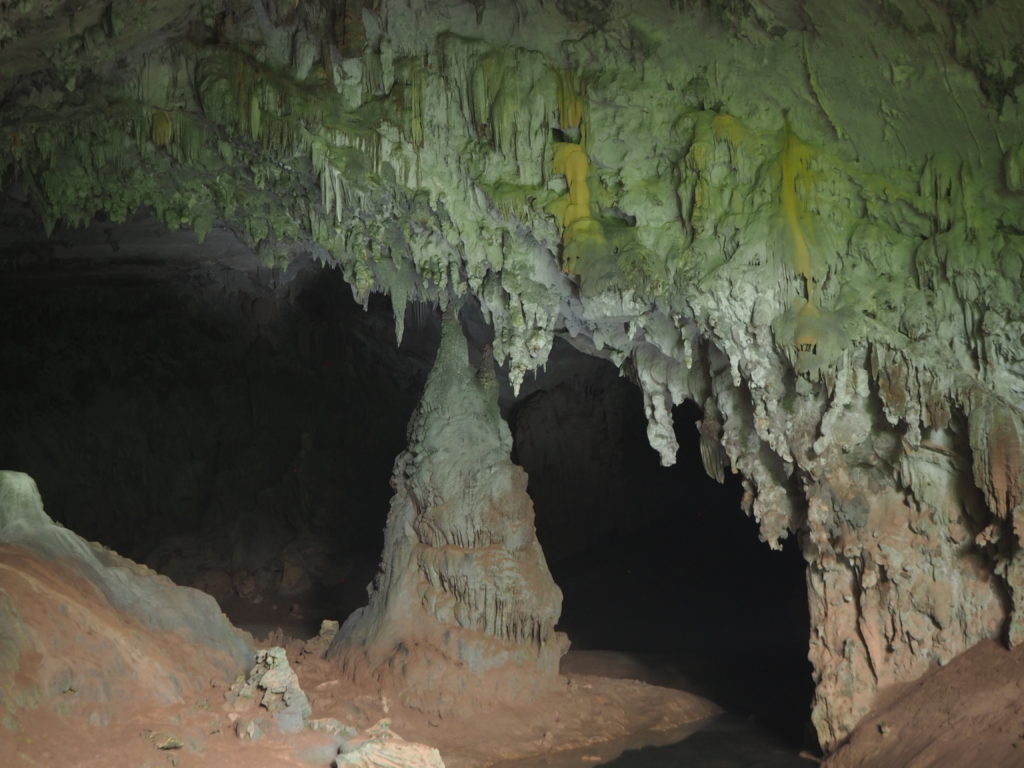

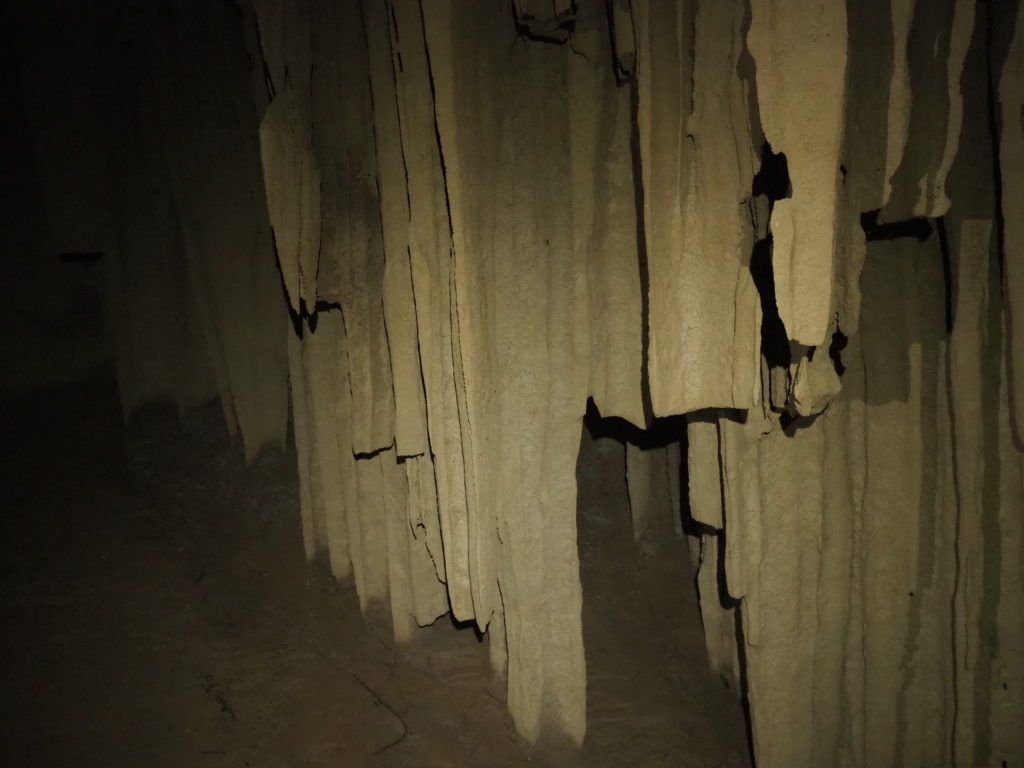
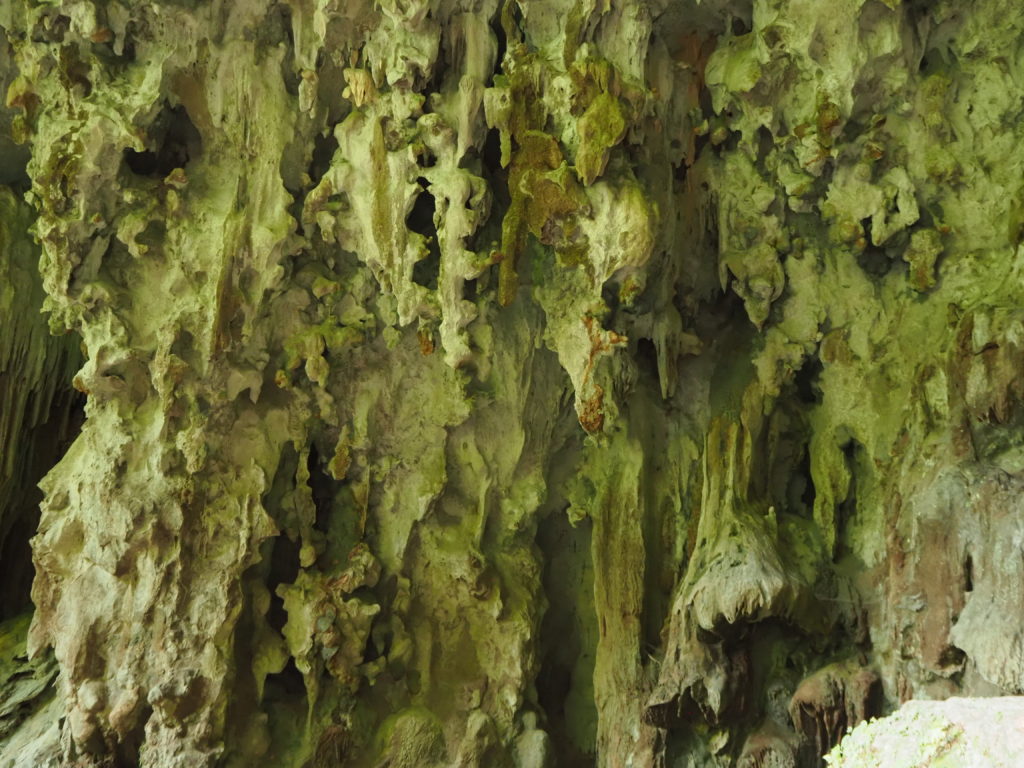
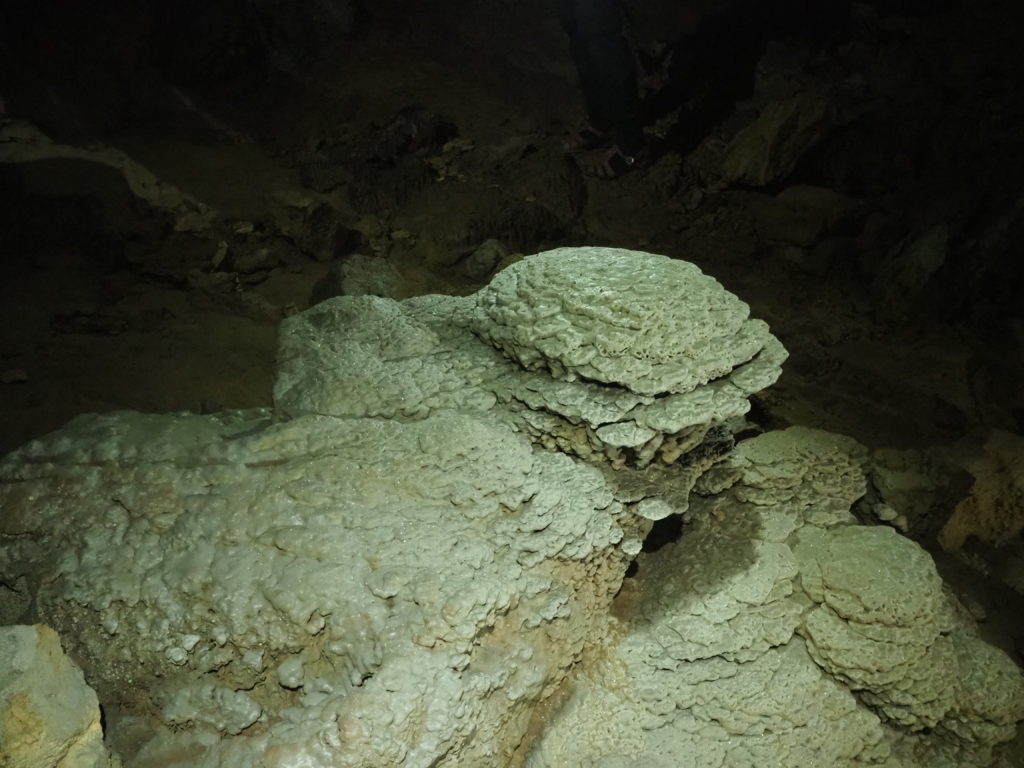
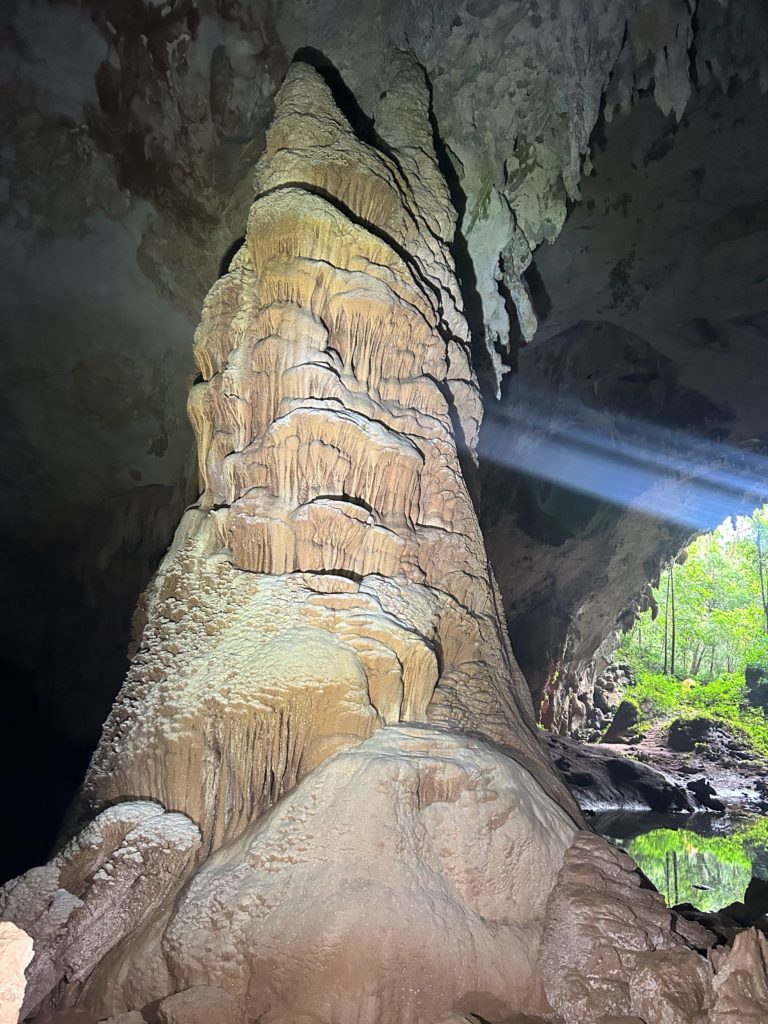
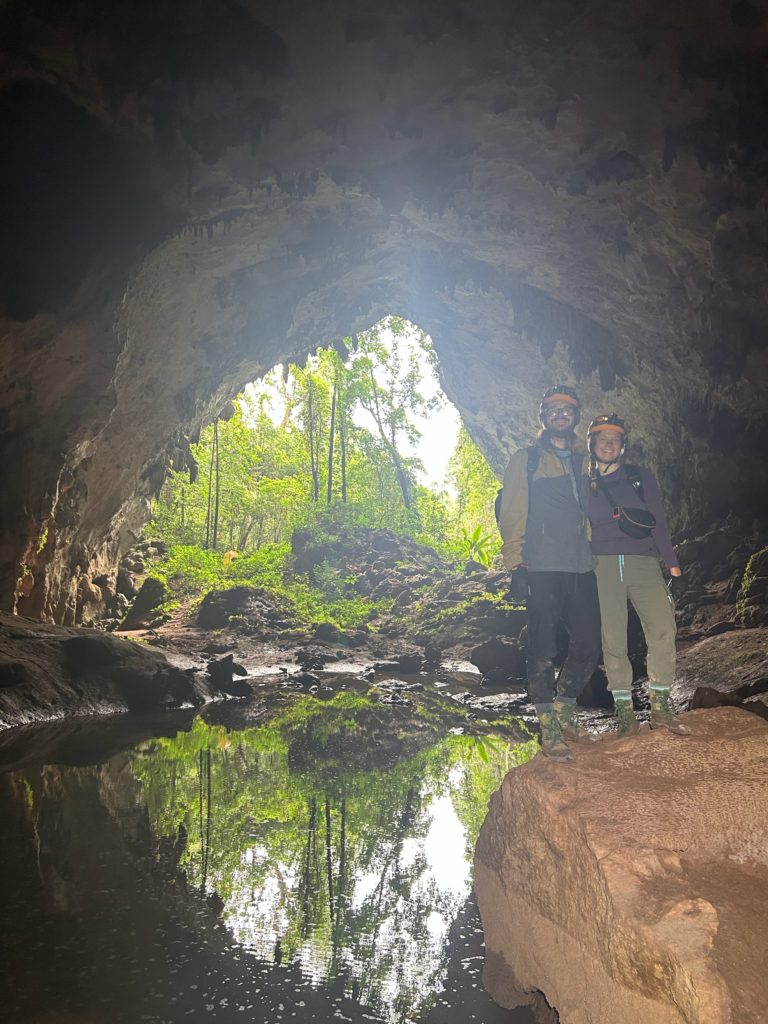
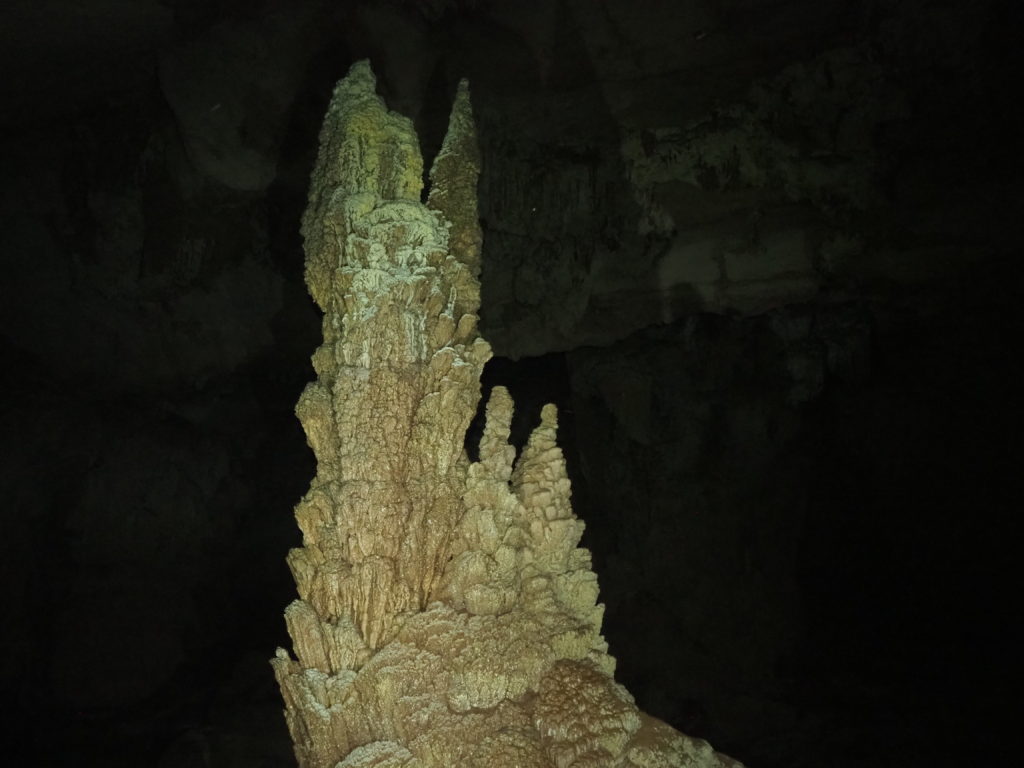
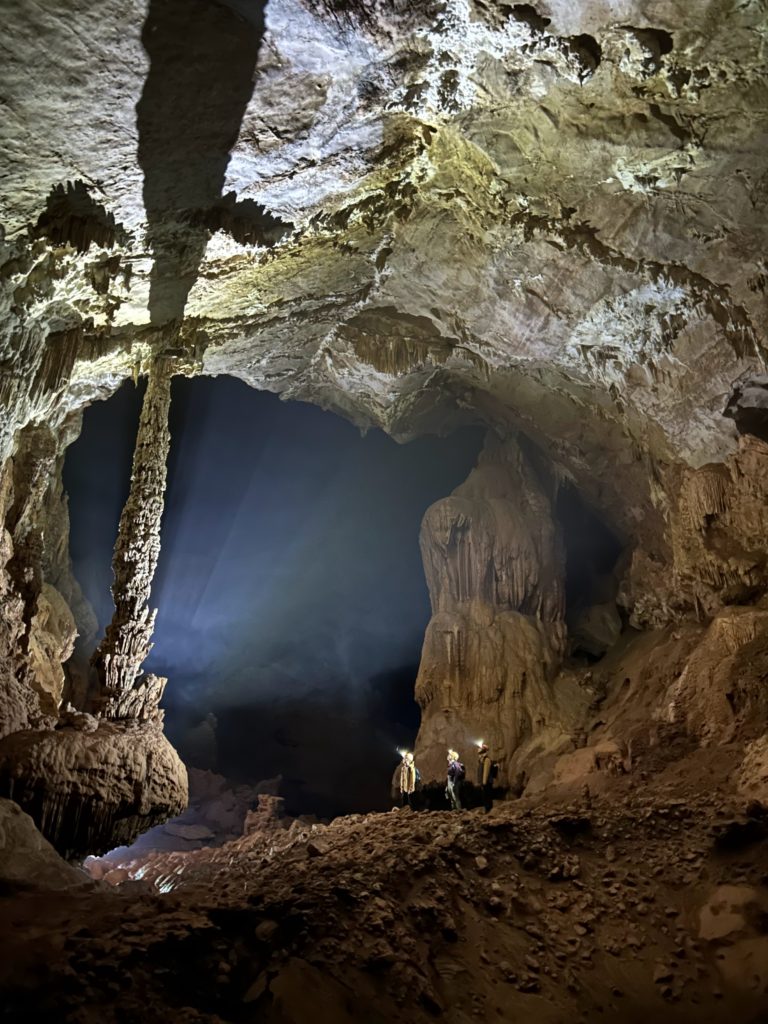
Back out hangover cave and into the jungle. We were in a small collapse now, but you really couldn’t tell. The vegetation around us was too dense. It was a tricky 10 minutes to the finale cave. Pygmy cave. The fourth largest in the world.
During both Indochina Wars, the jungle played major homefield advantage for the Vietnamese. This terrain was complicated, and unlike almost anywhere else in the world, 3D. The presence of jungle caves provided shelter and passage in stealth. The cave above Pygmy cave is known as Information Cave, and it was where parts of the government lived for portions of the second Indochina War (Vietnam war). While trekking through the jungle, we could see many remnants of the wars, like an abandoned rusted AK47, and old hooks for telephone lines.
The entrance was insane. It was as if there was a rift in the continental crust itself, and Pygmy Cave was the result. The floor of the cave was littered with jungle debris. Massive tree trunks that looked like twigs in the sea of even smaller woodrot. It all sloped down to the left, to a perfectly circular hole, getting steeper and steeper as the base approached black. It looked like a gateway to hell, and we certainly wanted to avoid it. So we went right, where we were supposed to go.
This terrain wasn’t any easier though. The plan to get through Pygmy Cave was to walk beside a bulbous calcium growth, above the trees below. From there it got dark, and we attached ourselves to ropes. The plan was to crawl alongside the side of the cave, just ignoring the massive drop to our left. We followed King through the first part, army crawling through some sections. From there we could stand up. We were now on the “dinosaurs back,” named after the Spinosaurus. We were walking on top of a long, narrow, stalagmite, with drops to blackness on either side of us. Thankfully, still attached to the ropes.
We made it to the end of the dinosaurs back, where it now dropped on three sides, and rappelled a surprisingly short 6m down to the floor of the cave. Finally unhooked from the ropes, we had a nice easy walk to the other entrance of the cave, and our camp for the day. Finally. Three caves later.
The Kong Collapse was the coolest campsite we have ever camped at. The Pygmy Cave entrance is a very close second. The mouth of this cave is impossible to guess the height of. 150m maybe? Just as wide too. The upside-down perfectly parabolic opening framed a luscious jungle on the bottom half, with a dirt path in the middle, and the still white cloudy sky above. Around us were all sorts of cave gubbins. Like an entire wall of calcium pools, all filled with mud. And gills plastered in arbitrary spots on the walls. At the entrance were some bamboo and ropes tied to the cliff face, which were used by a local to illegally hunt sparrows in their nest.
We had our family dinner in the cave again. The highlights were the peanut sauce eggplant, and the lemongrass chili chicken. King brought his flute, and played an evening lullaby. The reverberations from the cave walls made a beautifully serene sound as dusk set in. When the sun sets, the cave gets dark, so we went to bed. We fall asleep to the sounds of the swallows.
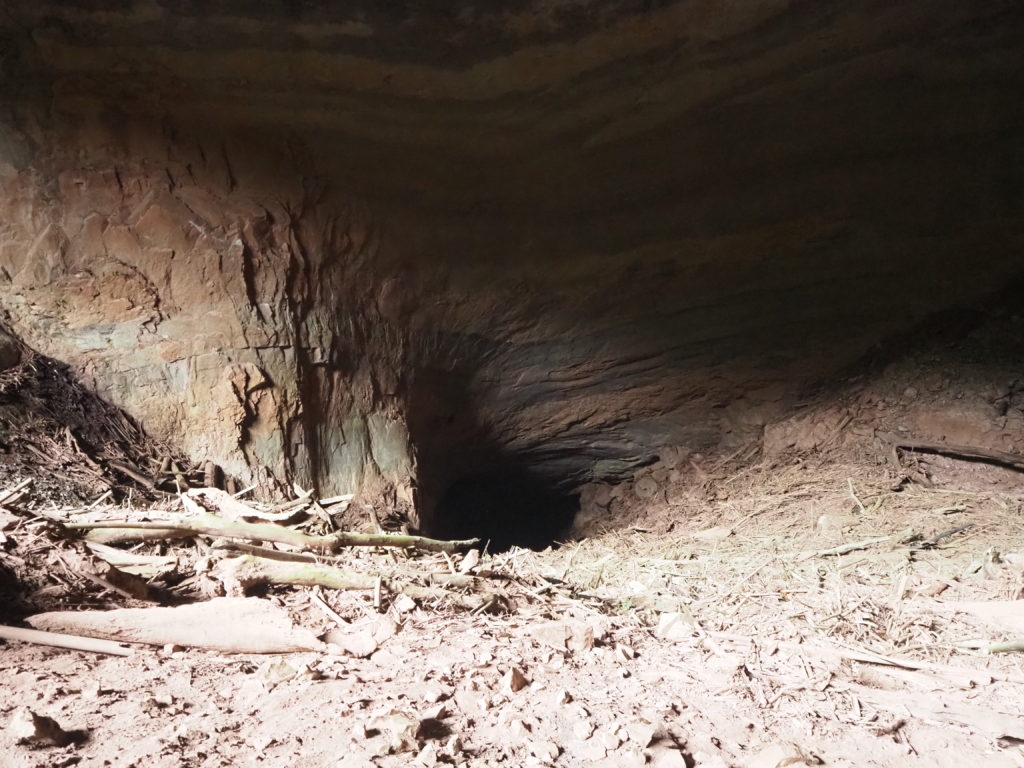
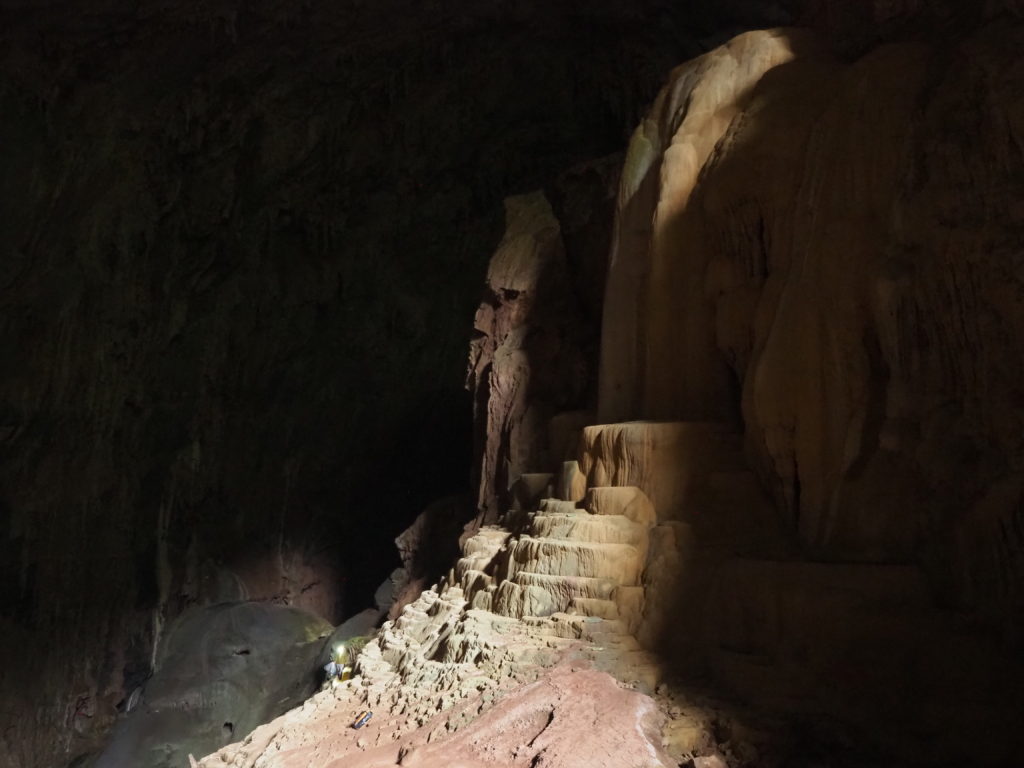


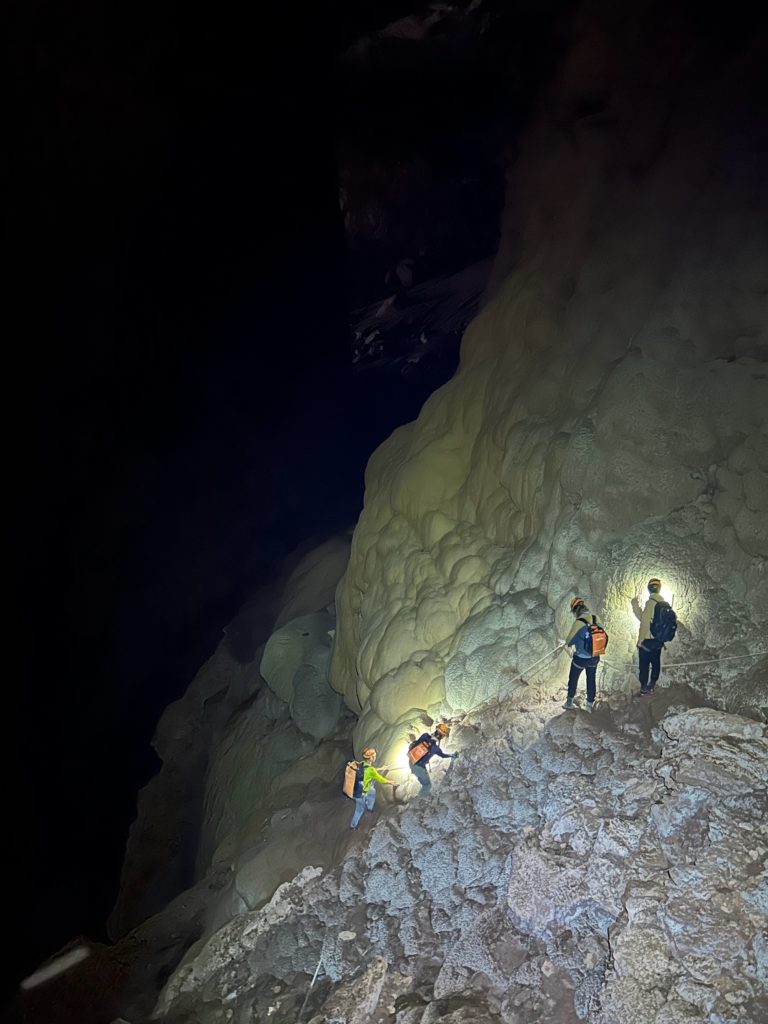
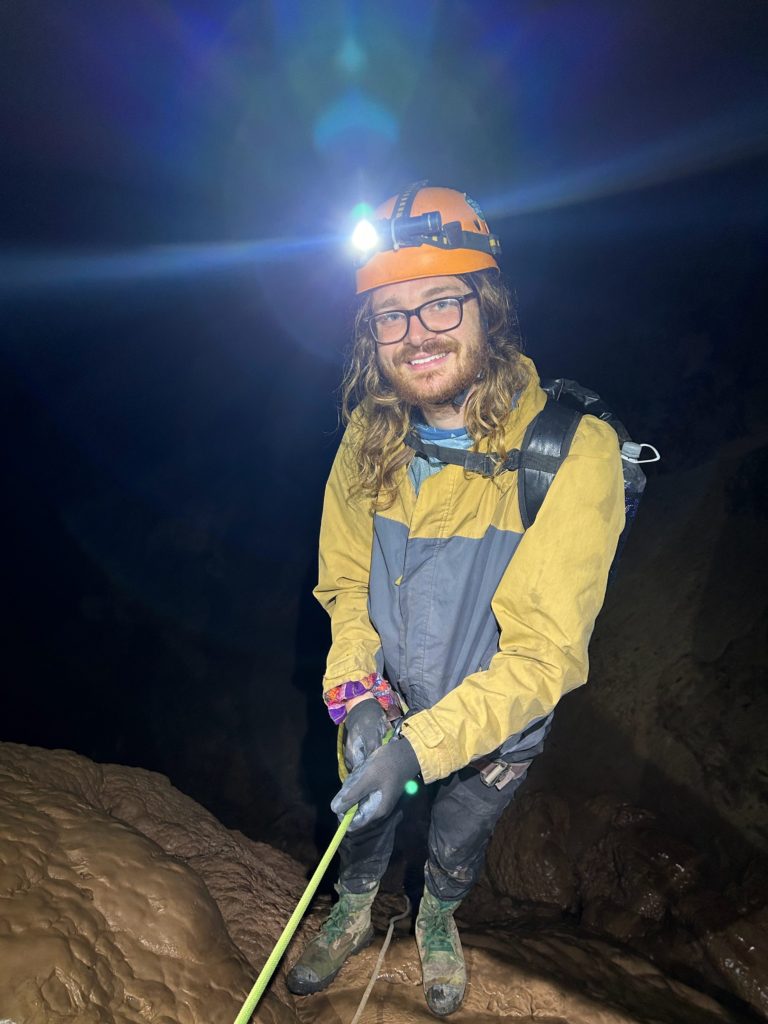

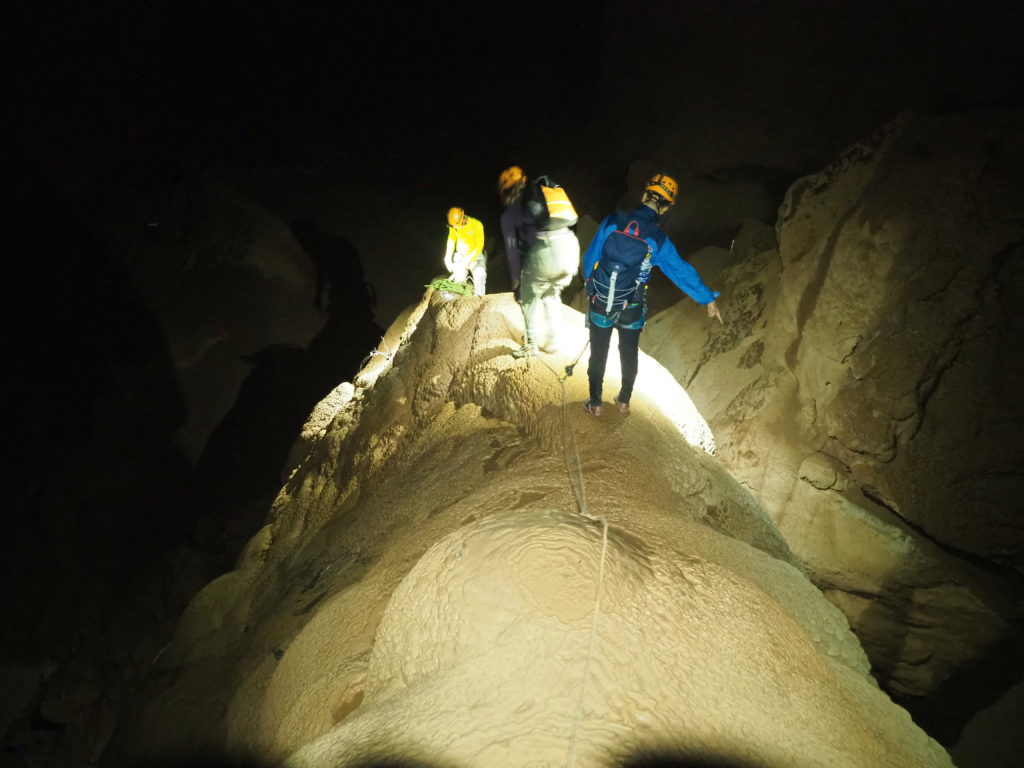
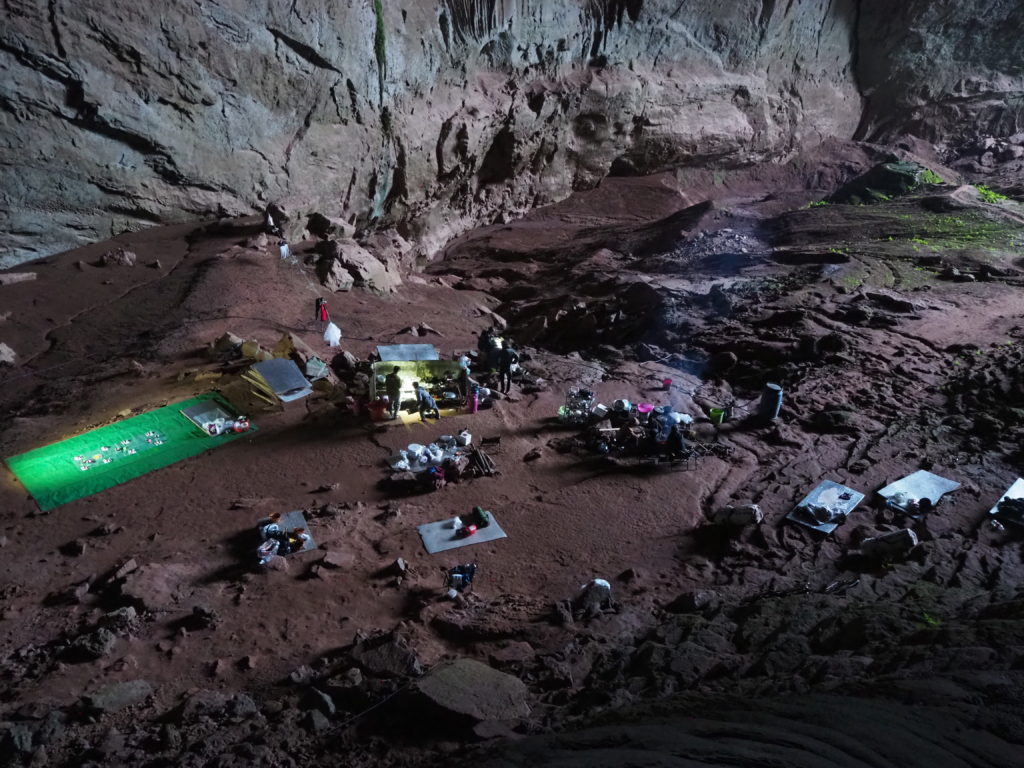


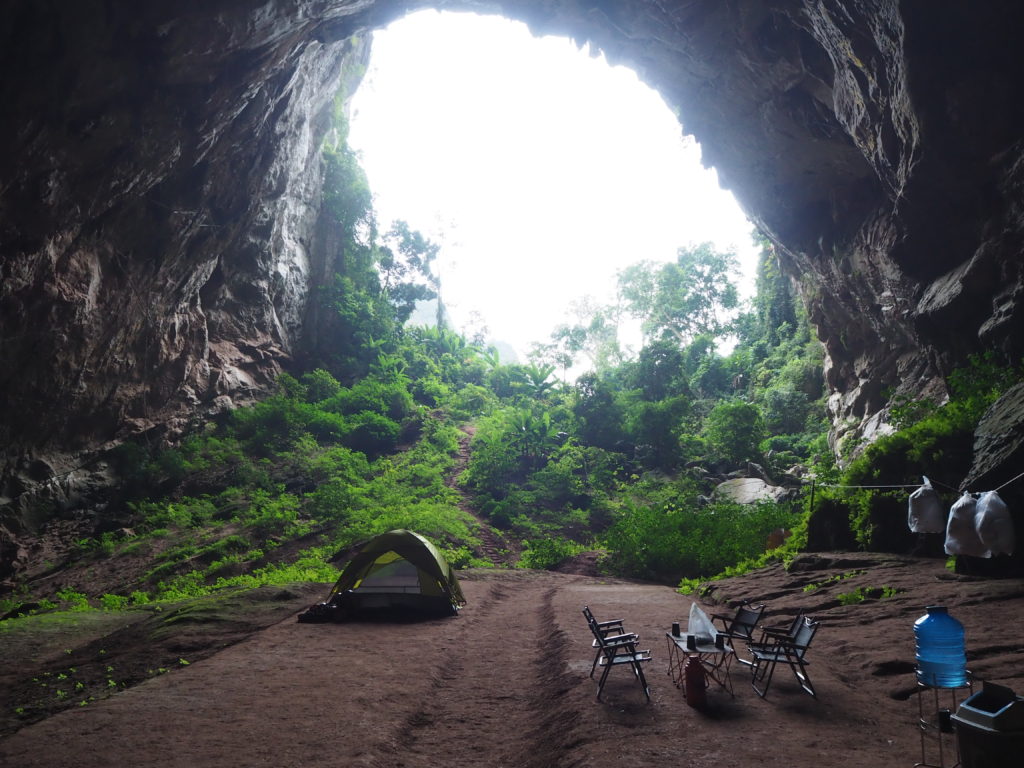

Bright and early we woke up to something we hadn’t seen in a week. Blue sky. And sunshine. Sweet sunshine. We couldn’t actually see the blue, as the contrast with the dark cave was too much for our eyes to handle. But the sun ray’s penetrated into the cave and our skin.
Breakfast was a nice bowl of pho with banana pancakes. We packed up, and our advanced party left again ahead of the porters. We departed up the dirt stairs and into the thick jungle. Silent goodbye’s were said to our cave and the adventures they gave us. But then looked up. We were still in the cave. After another 100m of hiking out, we could look directly up and see sky. Blue sky at that. We turned around to say goodbye again, but could only see the foliage behind us. There’s no way to see the enormity that is this entrance of Pygmy cave from the outside. The jungle too dense, the mouth too big.
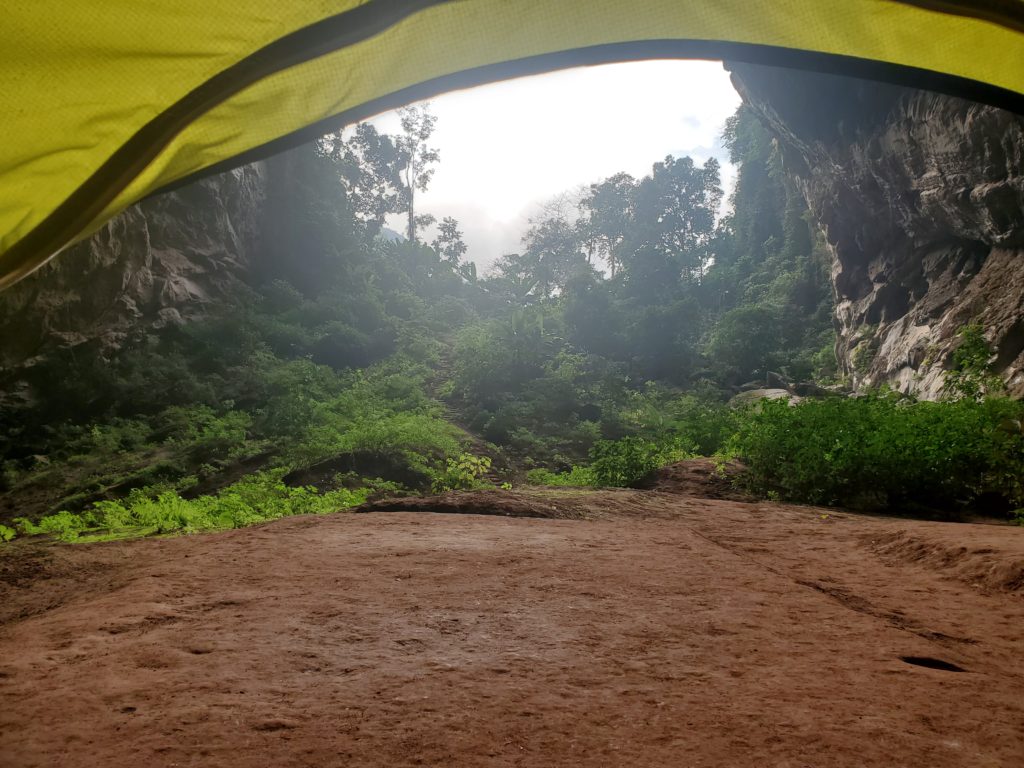
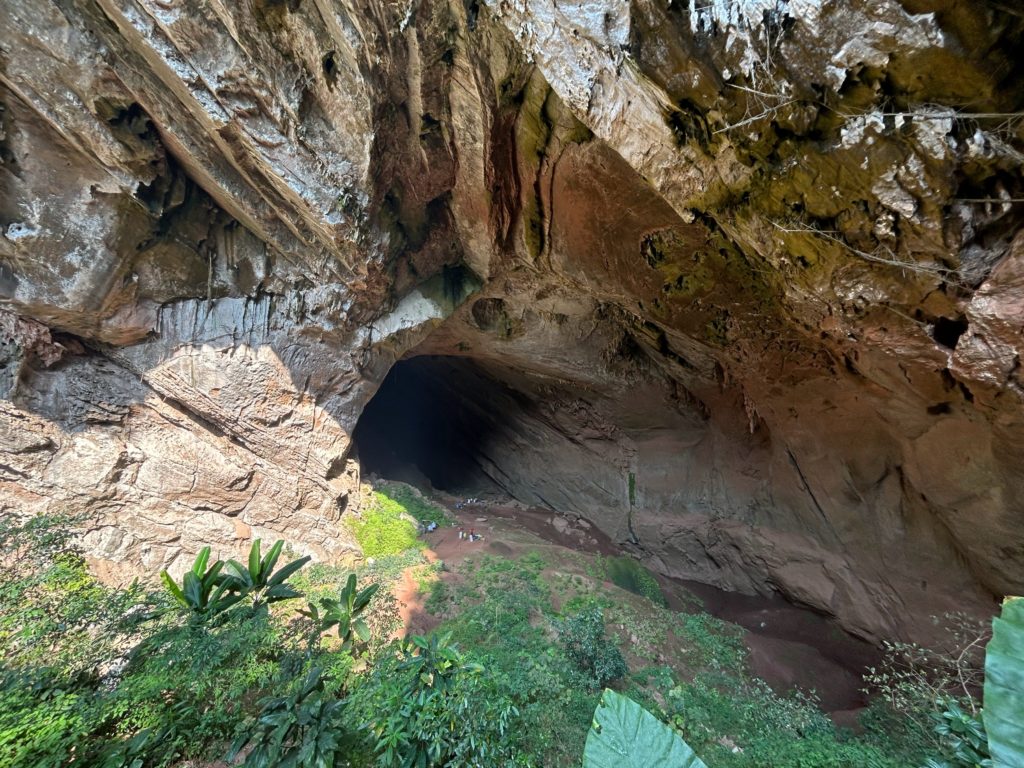
Back in the jungle, and we were ready to get back in the caves. The sun made it very hot and humid. Cam was still on alert for cobras and boars. Kong was on the lookout for spiky trees. The foliage was ever thick. A combination of banana trees, tall trees, and ropey half tree/ half vines that snaked around eye level looking for physical external support. Smaller vines weaved their way up the trunks of neighbors. We could hear the howls of monkeys, the non-stupid kind, and the songs of all the birds. The porters quickly caught up to us on a steep ascent, and their whistling got the birds hot and bothered. So a symphony erupted for near an hour.
The first ascent was the hardest non glacial ascent we have ever done. It was 200m of vertical at a 45 to 60 degree incline. There’s no time or room for switchbacks here. Short but powerful to the top, we had a great view of the chaotic elevation of the green covered landscape around us.
The rest of the path was a smooth and flat descent between the everything. Cam was on leech patrol, spraying any hitchhikers with their death sentence of lemongrass juice. We had an early lunch of make your own spring rolls. Lettuce, rice, pork and cucumber were laid out before us, with a peanut and a chili sauce. Everyone was still full from breakfast, but that didn’t stop me from devouring at least 20 rolls. They were so fun to make, and so good.
After lunch, the last hour in the jungle commenced. It was a slight uphill back to the road. The heat was getting too hot. After so long of wanting the sun, all we wanted was for it to go away. But we powered though, and made it to the waiting van, who had cold water and cola for us on arrival. We packed into the van, and headed back to Phong Nha to relax for the afternoon.
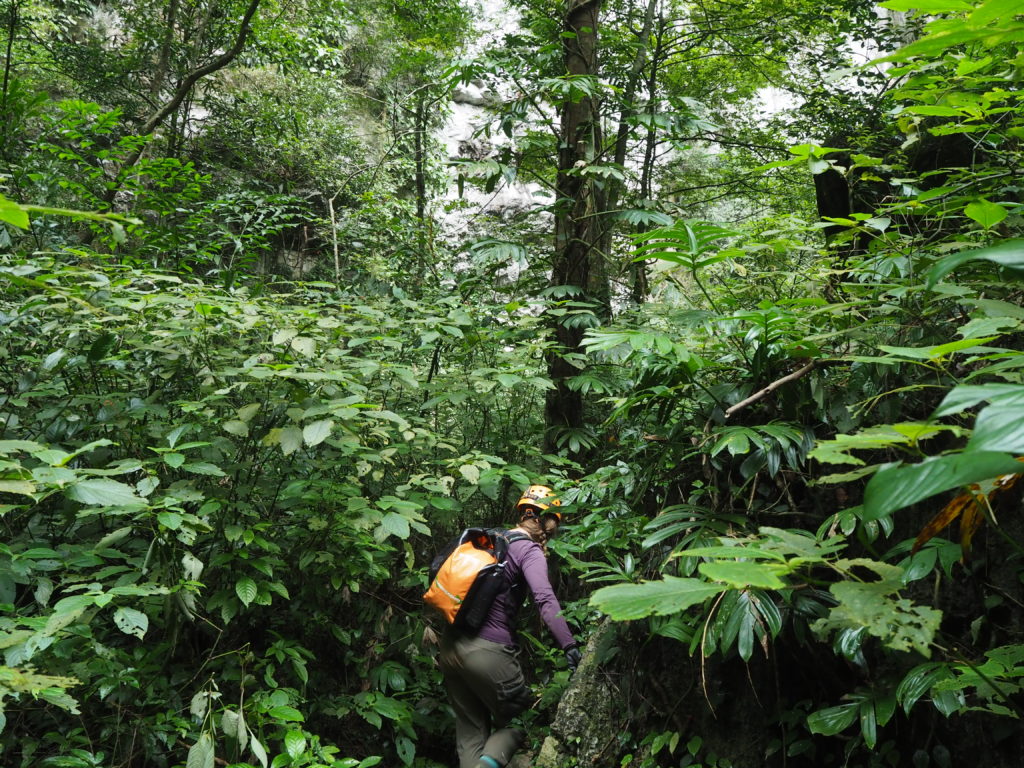
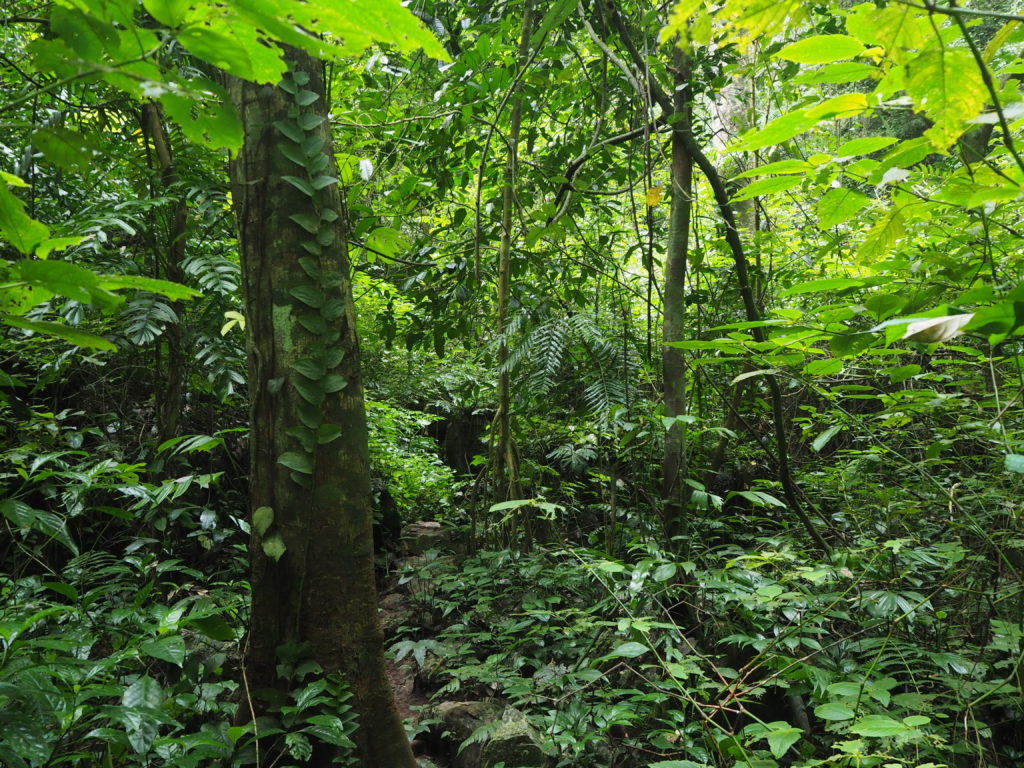

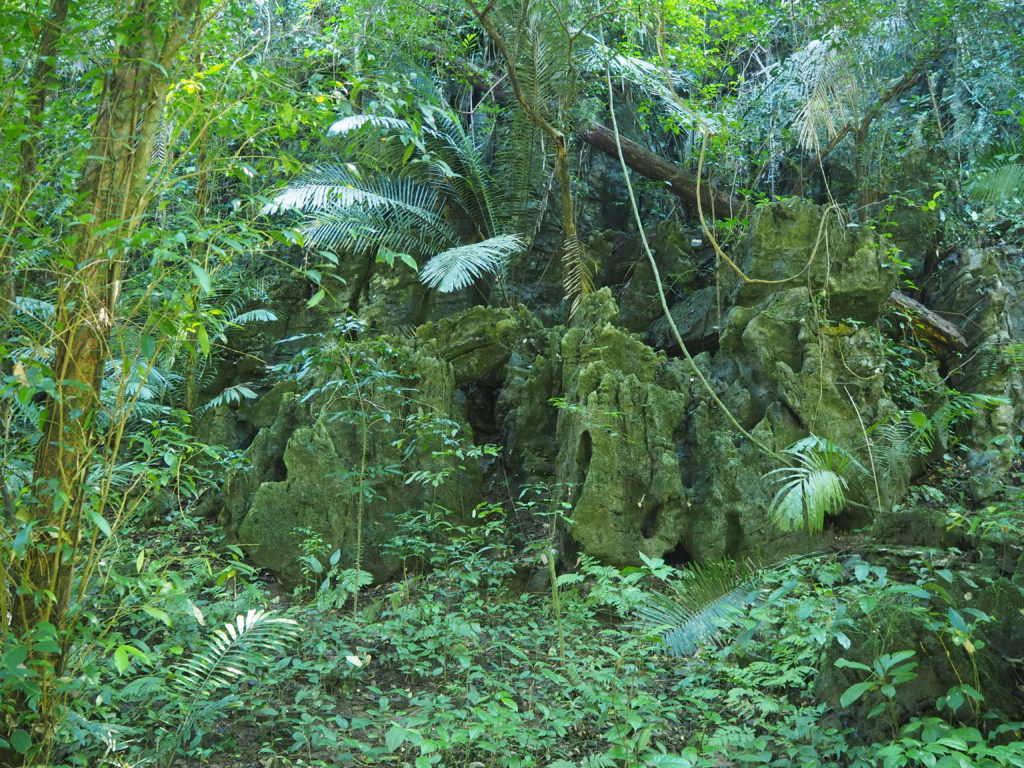
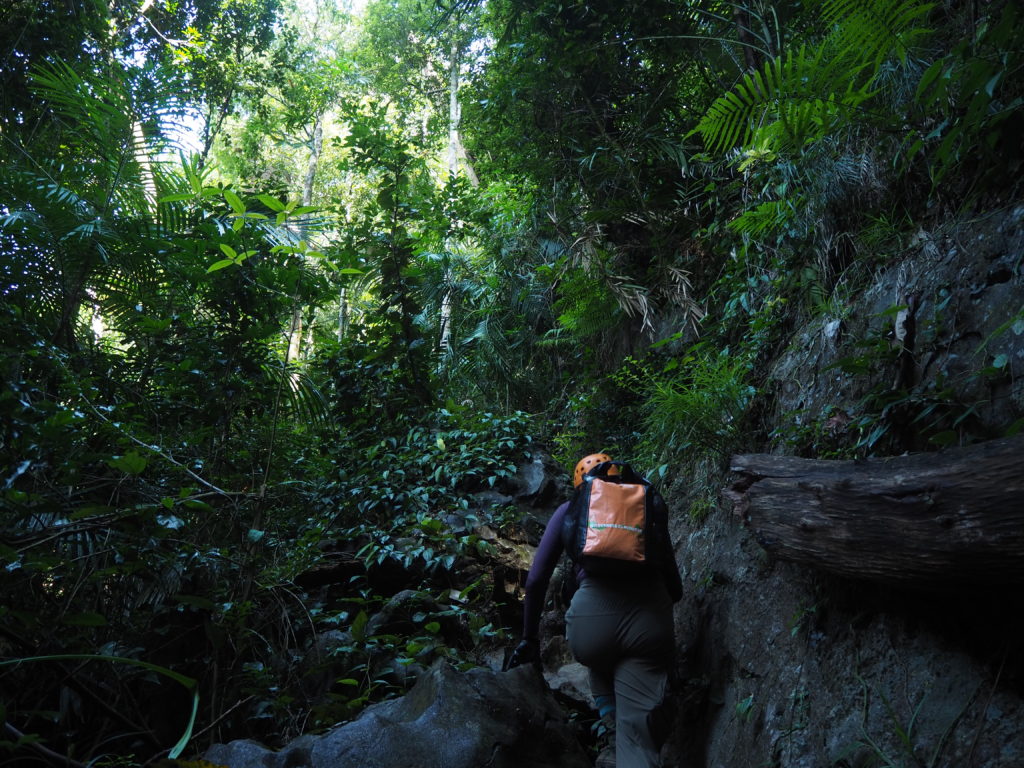
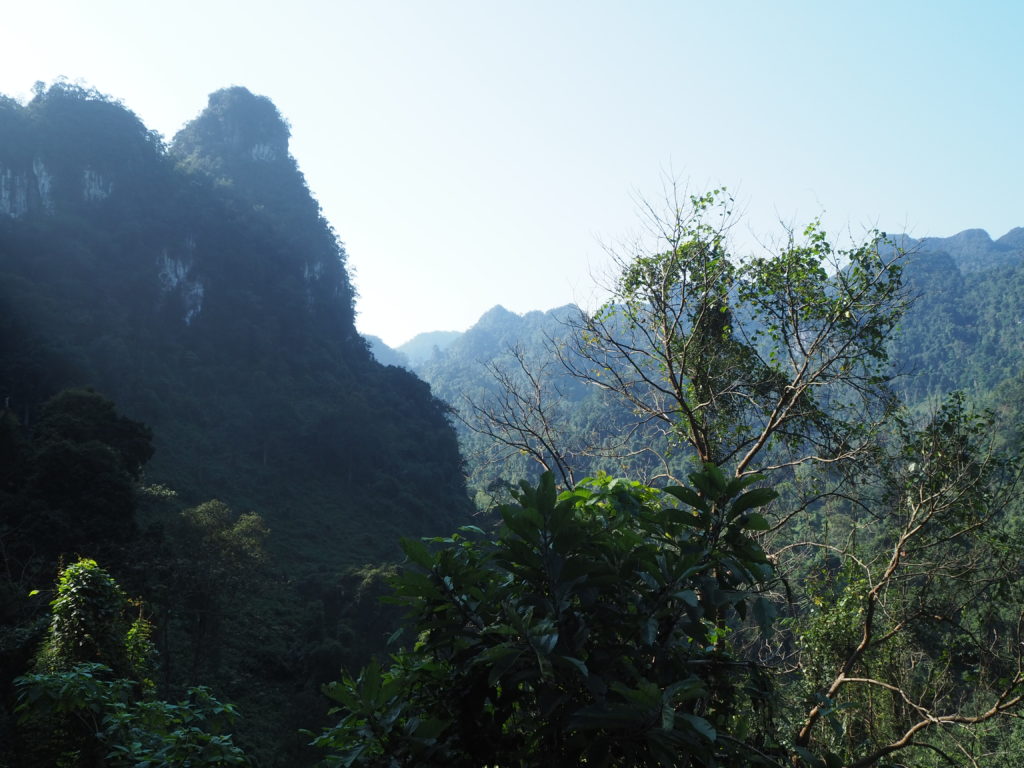
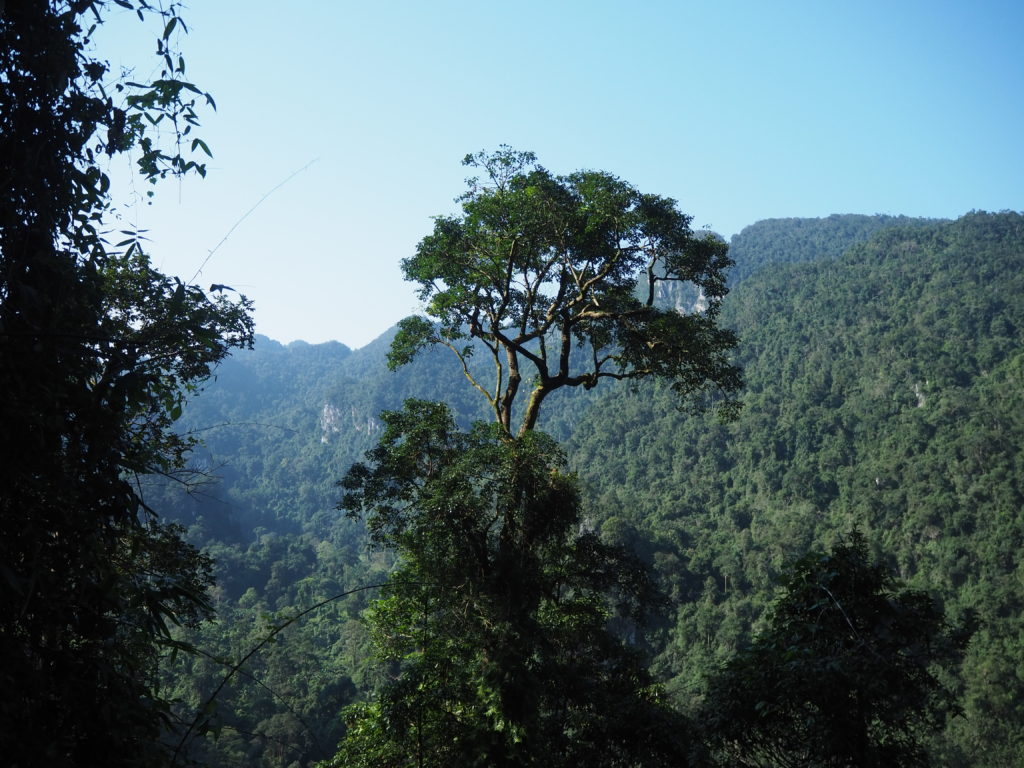

Caving was an adventure unlike any other we have done. After telling ourselves that we would never do it so many times, we (I) jumped at the first real opportunity to do some proper elite caving. Cam came along for the ride. The types of terrain were completely unique to only this region of the world, and were some of the coolest sights we have ever seen. We swam through a cave to our camp. And that was the logical way to get there..
It was quite something, but I don’t think it needs repeating in our lives. We like daylight. Sunshine. And only exploring on the 2D plane. Much harder to get lost.

Un – freakin – believable! You kids are soooooo adventurous! Jungle safety – king cobras, wild boars, leeches, 5-10kg eels. Swimming in the caves, climbing the rock walls. This adventure wins the prize – another prize – for “WOW – What a great adventure!” You remind us all that we do indeed live in a beautiful world – thank you for sharing your adventures Precious Travellers!
Oh! And the tree yoga pose in the photo ….. beautiful!
Spelunking to the extreme. Is cave diving or cave base jumping next?
So the cause of a karst collapse is essentially a scientific unknown, suggesting when it might happen again or continue at that spot is also unknown. And you were comfortable enough crawling around this thing and sleeping under it. I don’t even like driving through Frank Slide. You are braver than me …
Regardless, the entrance of these things seems like a great place to send a satellite text from. Then we would know where to start digging … lol.
Looks like quite the spectacular adventure.
Love Dad
Couldn’t agree with you more Mark!
No kidding….
Epic adventure, something Indy Jones would be proud of. Good on yourselves for safely pushing out beyond the mainstream touristo comfort zone.
Stunning geology, great pics, memories to cherish for ever. Boy Scout badges all around. Educational to understand the natural energies that shape our landscapes. Sounds like Kong & King know what their clients want, deliver in gold. Well done!
Unbelievable what you are seeing and experiencing! And where are your meals coming from and getting to you?? Really interesting to see what actually exists in other pars of our world. How neat you are doing this. Thanks for sharing! Love and prayers, G’ma
Wow – not sure I would be signing up for that tour!